
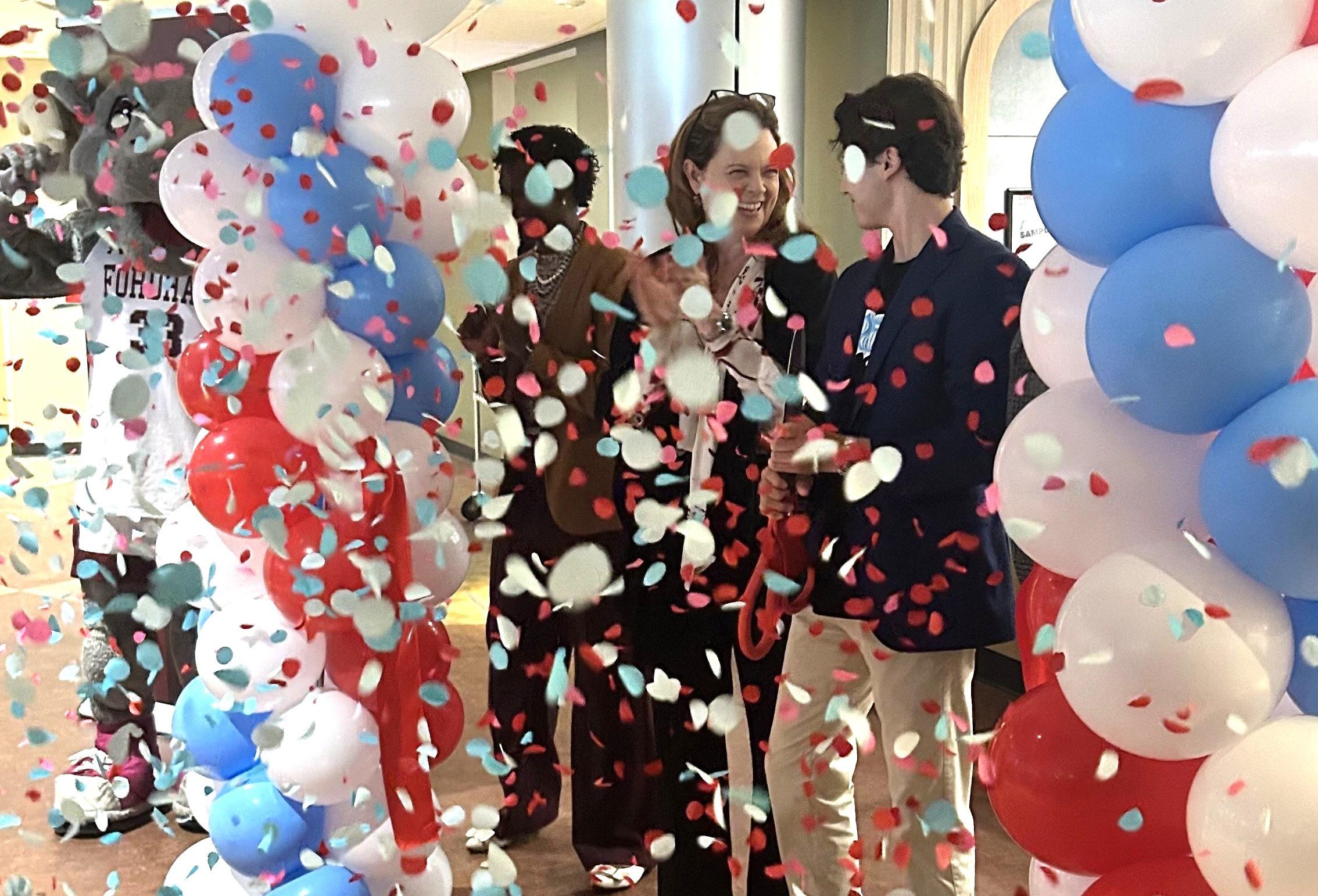



By LALLEYAH CAMARA ASST. NEWS EDITOR
Saxbys opened its first New York location at Fordham University’s Lincoln Center campus on Wednesday, Oct. 1.
The grand opening was attended by University President Tania Tetlow, Saxbys Founder and CEO Nick Bayer, Student CEO Aidan Engelmann GSB ’26, Aramark Collegiate Hospitality’s Vice President of Growth Chanel
Brown and many students, faculty and staff.
The student-run coffee chain commemorated its opening with an event in Fordham Lincoln Center’s Garden Lounge, located to the right of the newly opened Saxbys Coffee.
The event began promptly at 10 a.m. with a lively DJ, free merch for attendees in the form of a reusable cup, games, prizes and samples of Saxbys
By RISHIKA LINGAMDINNE CONTRIBUTING WRITER
According to Fordham University alumnus Peter Zangari, Ph.D., FCRH ’89, Artificial intelligence (AI) isn’t just another tech wave; it’s a new research workflow, a new way of learning and, increasingly, a new on-ramp to jobs.
That’s the insight behind a $1 million gift that establishes the Zangari Family Faculty Research and Innovation Fund to support interdisciplinary AI projects across finance, economics, data science and beyond.
Zangari, who has led teams across Wall Street and is currently teaching a Fordham course on AI and financial markets, frames AI less as a magic trick and more as a multiplier. For students, Zangari says the impact will
be immediate and practical.
“AI is an uber-assistant, it makes an effective researcher, better students, enables faster and more learning and broadens perspective,” he said. The fund will back faculty projects that involve students and expand ties with industry, with the goal that companies “look to Fordham as a source of talent,” as reported in a Fordham Now article.
Crucially, the fund is seed capital for serious research and collaboration. Fordham’s planned Transdisciplinary Research Incubator aims to bring faculty from different fields into the same room, where AI tools can help them translate across disciplines. The incubator is aligned with Fordham’s strategic plan, which wants to put the University at “the forefront
SEE ALUMN, PAGE 5
coffee and pastries.
After guests were invited to try samples, Saxbys founder and CEO, Nick Bayer, introduced inaugural student CEO, Engelmann, to speak to the crowd. “New York is our campus, Fordham is our school, and Saxbys is now our cafe,” Engelmann said.
Tetlow relayed her excitement and hope for Saxbys
SEE SAXBYS, PAGE 4
By SIENNA REINDERS NEWS EDITOR
Jennifer Petra was recently hired as Fordham University’s vice president for University Communications. In the position, which is also referred to as the university spokesperson, she will replace current vice president Bob Howe.
According to an article by Fordham Now, in the position, “she will oversee Fordham’s internal and external news functions, crisis communications, and media relations, all in service of elevating and protecting the Fordham brand.”
In an email, Petra said she was drawn to the position because Fordham’s values align with her own. “One of the things about this position at Fordham that I was most excited by was the opportuity to take what I had learned over the years and use it to make a difference as part of an organization whose values I really believe in,” she said.
Petra is a New York native,
SEE PETRA, PAGE 4
By EMMA LEONARDI ASST. NEWS EDITOR
Fordham University’s Orthodox Christian Studies Center is set to relocate to an official, permanent location, which is currently undergoing renovation, and is situated across from Faculty Memorial Hall. The mission of the Orthodox Christian Studies Center is to incorporate Orthodox traditions and history into Fordham. According to Fordham’s website, “the Center supports a multitude of research initiatives, publications, lectures, and a thriving undergraduate minor in Orthodox Christian Studies.”
The Center was founded in 2012 by its co-directors George Demacopoulos and Aristotle Papanikolaou. The reconstruction and restoration of the buildings on Belmont Ave. will be the first dedicated physical space for the center since its founding, as it has previously existed in other university buildings. The renovated building will
SEE ORTHODOX, PAGE 5
By JORDAN DONEGAN STAFF WRITER
After almost two years of planning, a new coffee shop has opened just outside of Fordham University’s Rose Hill campus with the goal of creating a safe and empowering space for a community group of women while connecting Fordham students with local Bronx residents. Grounds Café, located on Hughes Ave., is the product of a recent project of Her Migrant Hub, a Fordham-based organization that aims to improve access to mental health care for migrant women in New York City. The café was created in partnership with the Grupo de Mujeres Latinas (GML), a community group of women based at the Church of Mount Carmel, as a way to build a safe and empowering space for the women and a space where Fordham students can connect with the local Bronx
community. The café opened on Wednesday, Oct. 1, and will be open Monday, Wednesday, Friday, Saturday and Sunday from 9 a.m. to 5 p.m. going forward.
“We want to make sure that people are welcome into this space,” said Marciana Popescu, Ph.D., co-founder of Her Migrant Hub and Fordham Graduate School of Social
Service professor. “I think the main goal of the cafe right now is to restore hope and create a place where everybody is welcomed and feels they belong, one coffee at a time.”
The idea to create the café emerged from early conversations between members of Her Migrant Hub and other female activists across New York City
SEE GROUNDS PAGE 5

Finlay Hall Oct. 4
4:05 a.m.
On Saturday, there was a fire alarm in Finlay Hall. The supervisor and NYFD responded. The investigation revealed a student cooking food triggered the alarm. The supervisor ventilated the area and reset the alarm panel.
Southern Boulevard Oct. 1
7:11 p.m.
On Wednesday, an employee reported that their vehicle was broken into on Southern Boulevard. The supervisor responded. The employee said they parked their car at 2 pm. When they returned, someone had broken their window and removed property. The supervisor contacted the NYPD to respond and prepare a report.
Arthur House Oct. 1
7:20 p.m.
On Wednesday, there was a smoke alarm in 2451 Arthur Avenue (Arthur House). The supervisor and FDNY responded. The investigation revealed a strong smell of marijuana as well as a smoke condition in the basement stairwell. The supervisor ventilated the area and reset the alarm panel.
Southern Boulevard Sept. 30 2:03 p.m.
On Tuesday, a Ram Van operator reported an accident at Southern Boulevard near Fordham Prepatory Gate. The supervisor responded. The investigation revealed a Jeep was merging onto Southern Blvd from Bedford Park Avenue. The operator of the Jeep did not stop and struck the Ram Van. There were no injuries.
By ANDREW MASSIE FEATURES EDITOR
At Fordham University’s Rose Hill campus, the math of where to live is never only about square footage. It is about time, community and how quickly a place starts to feel like a life.
For Monika Mukerji, GSB ’29, Martyrs’ Court was not the dream assignment. “First was Loyola [Hall], then it was Loschert [Hall], and I’m pretty sure Martyrs’ Court was our fourth choice, but we got put into that, so it’s okay,” she said.
Surprise turned into acceptance. “I was honestly a bit surprised, but I didn’t mind it. I’m pretty adaptable,” she said.
Mukerji arrived with a preview that many first years do not have. She had dormed at Queen’s Court during a summer program, so communal living was already familiar to her. “When I got in and committed to Fordham, I knew what I was going to experience,” she said.
The first-year basics have done their job for her. “It has the necessities that a freshman needs for their first year. It has enough closet space, it has a desk, a bed,” she said.
If Martyrs’ rooms are tighter and the stairs are narrow, the trade-offs are predictable comforts. “There are two bathrooms on our floor, so it’s nice to decide which one to go to,” Mukerji said.
The dorm’s laundry room has been “spacious” and “working smoothly,” though she added the basement trip is “quite of a walk.” She has heard friends share rumors about bugs and complain about the lack of elevators and her verdict is the same. “As a freshman, living at Martyrs’ Court isn’t so bad,” she said.
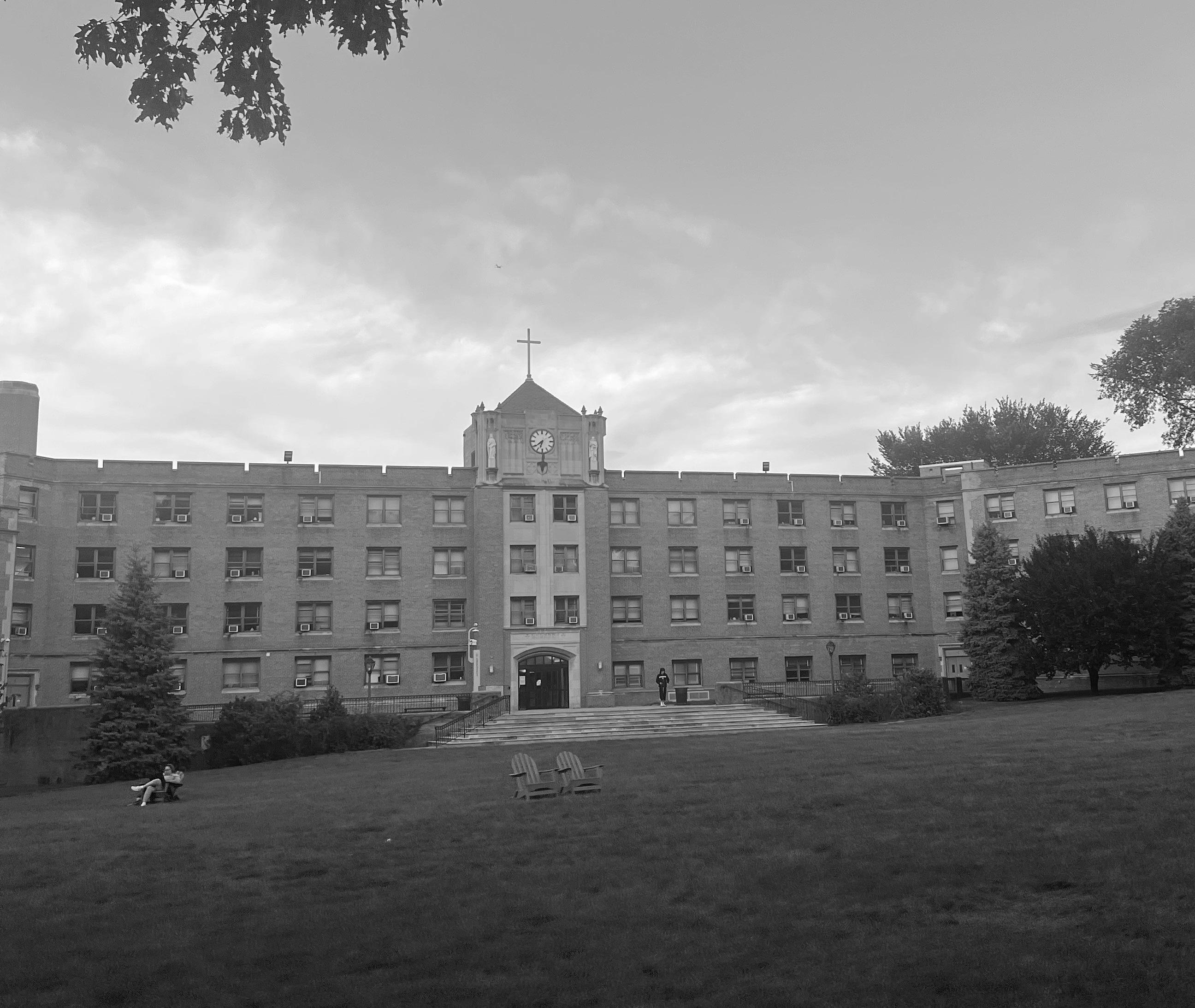
adult rhythms rose to the top.
“Kind of just having my own kitchen in a single, I think, is something that stands out to me,” Pontecorvo said. One big tradeoff, though, is time. “It does take longer to get to the gym sometimes or to classes, and it is kind of weighing what you do value more,” he said. With extra autonomy came a new daily lifestyle. “Your rhythm of life begins to evolve more around an entity that isn’t on campus,” Pontecorvo said. “I think it’s more deliberate now when I see a lot of my friends … because I don’t live in the same building as my entire friend group, it’s much harder to see them now.”
that make first-year housing function.
He started in the Resident Housing Association, then became an RA because he loved building programs and community. “It is a job, and you need to be taking it as a priority,” he said. The invisible hours stack up fast. “The three things that definitely take the most time is these bulletin boards that we’re required to do … The main programs take up a lot of time … Then being on duty is definitely taking up a lot of the time.” RAs receive free housing, but there is still work to get done.
“kind of brought people closer together.”
Multi-floor lounges, such as those in Alumni Court South, create “sections of communities” with their own distinct identities. And when the budget tightens, the programs that bring new students to the campus can suffer.
Follow The Fordham Ram on Instagram, Facebook and X @TheFordhamRam
Thursday Oct. 9
2025 Internship Fair
McShane Campus Center 12 p.m.
Fordham is hosting it’s 2025 Internship Fair. This event is open to all industries and provides the opportunity to meet employers looking for interns from various areas and interests.
A few blocks from campus, Michael Pontecorvo, FCRH ’27, is living a different lifestyle. He stayed on campus for two years, including his first year at Loyola, in the Integrated Learning Community. Sophomore year brought a private bathroom in Finlay Hall and a mixed community of class years.
That mix hinted at what he would value most off-campus as a junior. Space, control and
Pontecorvo is pretty frank about the value proposition. “Oftentimes it is cheaper, or if not cheaper, rather quality of life to price is better off campus than on campus,” he said.
The comparison can sting for friends who are still in the dorms. “It does kind of evidence the disparity between the amount that you pay and where your money might be going,” Pontecorvo said.
Back inside Alumni Court South, Tristan Moore, FCRH ’28, a Resident Assistant (RA), sees both the learning curve and the load-bearing work
Moore sees how quickly small frictions scale when 25 people share a floor. “The laundry is a completely different beast,” he said, recalling a week when “four of our dryers have just completely gone out,” which “causes all these other backups that you just wouldn’t see with off-campus [housing].”
Bathrooms, by contrast, tend to stay orderly. “It’s one of those areas where it’s cleaned basically every day by the maintenance,” he said.
Moore is also clear about what makes first-year dorms matter. Lounges can shape friendships. A single lounge, as is the case in Loyola Hall,
Thursday Oct. 9 “By The Way, Meet Vera Stark”
Pope Auditorium 8 p.m.
The Fordham Theatre Program opens its season with twotime Pulitzer Prize winner Lynn Nottage’s political comedy “By the Way, Meet Vera Stark.” Inspired by 1930s screwball films.
Friday — Sunday Oct. 10-12 “Pride and Prejudice”
Collins Auditorium 8 p.m.
Fordham Theatrical Outreach Program will perform their production of “Pride and Prejudice.” Students are able to reserve tickets for free in the bio of @top_fordham on Instagram
Tuesday Oct. 14
Golf Classic
Winged Foot Golf Club 10 a.m.
Join the 2025 Golf Classic at Winged Foot. Enjoy a great round of golf with fellow alumni, parents and supporters at the iconic Winged Foot Golf Club which will be the site of U.S. Open in 2028.
“We get $300 a semester, and I don’t think that’s enough for the programs that I want to put on,” Moore said. “If we invested more budget into these freshmen dorms … we would see better returns on these freshmen coming back in their sophomore year [and] fewer … transfers because they just had such a good experience.”
Seen together, the first-year double and the junior studio are not opposites. They’re different chapters. Mukerji wants to stay on campus next year and keep the number of students small. “I think I will stick to max three roommates,” she said.
Pontecorvo is content with a kitchen, a longer walk and a schedule that requires intention. “There is the social aspect, there’s the ease of living,” he said of the dorms. But he said for now, “for what I was looking for, this option made sense.”
Friday Oct. 17
President’s Ball
Edwards Parade 9 p.m.
The President’s Ball will take place under the tent on Edwards Parade. This event is free and only open to current Fordham undergraduate students. Dress code is semi-formal attire.
By SIDNEY BLASCO CONTRIBUTING WRITER
The Artificial Intelligence (AI) at Fordham Club hosted an event titled “What’s The Point of College?” on Oct. 2 in the McShane Campus Center’s Great Hall. The event was the club’s first of the semester and was an interactive discussion about why students choose to attend college and how AI plays into those reasons.
Moderated by Margaret Konkel, senior director of the Center for Educational Innovation, the discussion reflected the unease among students and some university educators about how AI is affecting their future.
The club aims to bring students and faculty together to talk about AI at Fordham University, its impact on the education system and hear student perspectives with open dialogue.
Sean Huynh, FCRH ’27, the vice president of the AI at Fordham Club, thinks it is important for students to talk about AI. “The ones that refuse or don't want to talk about it are the ones we need talking about it most,” Huynh said.
Some students who attended had expected a more technical discussion of AI. Blake Zucco, GSB ’28, believes that learning the technical side of AI is important. “It’s becoming very prevalent in the school,” Zucco said. “I think I just need to get to learn it better because it’s the future,” Zucco added.
Other parts of the discussion surrounded the prevalence of AI in the job industry and the continuing benefits of a college education. “With AI, now you can simply get [a] job without a degree,” Huynh said. “We have to remember that the point of college isn't strictly to get a job. There are other parts of it that make it valuable.”
Tony Wang, GSB ’26, echoed this sentiment. “For the U.S. … a good college is actually a big source of finance, income, or money flow … in this economy,” he said.
Konkel then rebutted this statement and said she “could argue that you can have a really good working life without a college education.”
Some attendees said they believe that colleges need to do more to address all of the possible drawbacks of AI.
Alexa Henderson, GSB ’26, said that seeing how AI is “going to affect current students as they graduate [is] an issue Fordham and other colleges haven't fully addressed yet.”
Michael Peppard, a professor in the theology department, then brought up the definition of knowledge. “I think … university professors should be experts on what knowledge is,” Peppard said. “Ideally, like how knowledge is produced and how knowledge is generated in the act of educating. And I think that sadly … universities are not leading, I think we’re behind.”
Peppard’s statement is not to say progress is not happening, however. Jack O’Brien, GSB
’27, the president of AI at Fordham, said that the Fordham administration has been working “with students like us to adapt to AI, but it really is something that we’re actively working on together and hoping to see some results come to fruition in the coming months and years.”
Regarding student AI usage, “a lot of it really does depend on the individual student,” Huynh said. “How they’ve developed their own ethics, morality on using the technology.”
Konkel said AI usage in classrooms is currently “a one-by-one, classroom-byclassroom kind of experience.”
Fordham has not figured out a university policy on AI use in classrooms yet, but “there’s been a lot of conversation about [it],” Konkel said.
Peppard then said his own response to Generative AI was to change his curriculum. Peppard shared, “I decided to change everything, which was sad.” He has re-introduced oral exams and “a lot of inclass speech and debate … I try to have assignments that are either full AI or no AI and eliminate the muddling middle ground,” which he said is “where the worst education is happening right now.”
Peppard also said that it would be difficult for higher education institutions, such as Fordham, to create an AI policy due to the fast and consistent new technological

developments occurring in the AI industry.
Konkel then continued on to describe the ever-changing technology as a “wicked” problem.
“Things that formulate the problem are inherently in conflict with one another,” Konkel said.
Fordham’s challenge may not just be addressing AI, but ensuring its Jesuit mission continues in a world that values efficiency over ethics. “What we want Fordham to do,” Huynh said, “is to be able to prepare us as humans first and foremost.”
He said the university should help students become “critical thinkers and problem-solvers” while keeping in touch with the “moral component of the Jesuit
values that has made Fordham so successful over its 175-plus years of existence.”
Konkel asserted this same belief. “It’s that connection between, like, mission and action and outcome,” Konkel said. “Human outcome is specific and unique to the Jesuit tradition here.”
The AI at Fordham Club is a place for open dialogue about difficult conversations. “Whenever people talk about AI, it gets philosophical very quickly,” O’Brien said. “We’re hoping that that's a component of our club that people can engage with; something that they’re maybe missing out on in their usual classes … It’s an open club to all levels and all uses, ethical or unethical.”
By SOFIA SEMPER COLUMNIST
The Fordham University Rose Hill United Student Government (USG) met on Thursday, Oct. 2, for special elections and to announce proposal committees.
Executive President Lucas Hjertberg, FCRH ’26, and the Executive Vice President Andrew McDonald, FCRH ’26, presented Senator Ava Cascella, FCRH ’26, with the award for September Senator of the Month.
Hjertberg then announced that they would be conducting special elections for the Senate President Pro Tempore.
Senators Cascella, Ashley Garcia, GSB ’27 and Carter Soderberg, GSB ’27, were all nominated for the position. Cascella stated that she feels qualified for the position due to her prior involvement with USG and her knowledge of proposal and initiative planning. Garcia said that she has hunger and drive and, if elected, she would use those skills to help senators get their proposals passed. Soderberg, although nominated, was not present at the meeting and was unable to give a speech. After
much deliberation, Cascella ended up being announced as the new Senate President Pro Tempore.
The USG Vice President of International Integration Jenny Hong, FCRH ’28, then presented a budget request for an upcoming tabling event where her committee will be making matcha. The tabling is scheduled for Oct. 16 from 12:30 p.m. to 2:30 p.m. in the McShane Campus Center. Her budget request was approved.
Hjertberg then announced five new proposal committees, including the first one set to create a governing documents commission, the second one to create a senior survey, the third one to improve the registration website, the fourth one to offer lower-level meal plans and the fifth to improve summer living conditions. Every USG member was then placed into one of the new listed proposal committees.
Hjertberg then announced that he recently reached out to the Career Center about having research opportunities listed on Handshake so students would not have to reach out to professors. He explained that the Career Center directors are now currently working on
having this be included on the RamConnect platform, along with job opportunities from other employers.
The Career Center was invited to the next meeting so that they can discuss the new changes in the Career Center and so USG can ask them questions. Hjertberg also said that he asked why the pre-professional program website has not been updated; he was told that the Career Center has its own Information Technology center that is working on updating the website.
Then, Catharine McGlade, Ed.D., assistant dean for student involvement, first introduced Joshua Somrah, the new assistant director for Student Leadership and Engagement, as the new USG advisor. She also announced that the next Senior Week Event is set for Oct. 16 and that the Homecoming weekend tickets are now available to purchase.
The USG Vice President of Operations Tina Pathak, FCRH ’28, said that they have had four new club presentations this week, but they are being a bit more
selective with approving new clubs.
Vice Chair of the Budget Committee Siri Bhat, GSB ’27, said that the Budget Committee received about $20,000 in funding requests but has only approved about $12,000. She explained that the reason they have not allocated all of the funding is that Model United Nations had received a sanction. Bhat also announced that Budget packets will be sent out at the same time as the Operations packets and will be due on Nov. 1.
Vice President of Student Life Luc Angus, FCRH ’26, said that the Keating Steps event was very successful and that they had a large turnout. His committee also recently created a new subcommittee dedicated to updating the bylaws and club suite rules.
The Vice President of the Gabelli School of Business (GSB) Hunter Gholson, GSB ’26, then announced that the GSB Dean’s Council has two upcoming events on Oct. 23 — a Halloween event — and Oct. 30 — a marketing event.
The USG Vice President of Sustainability Ayden Johnson, FCRH ’27, said that he is
working on getting a new Fordham Flea liaison and that the Interdisciplinary Sustainability Panel has been postponed.
Vice President of Diversity and Inclusion Laila Sayegh, FCRH ’27, announced that their next tabling will be Oct. 21 and that Bronx Appreciation Week is tentatively scheduled for the week of April 13. Hong said that she will be inviting all of the cultural clubs on campus to participate in their Culture Weekend event.
Vice President of Facilities and Dining Maddie Ando, FCRH ’27, recently met with Fordham’s Counseling and Psychological Services for a discussion on a new proposal to help students get long-term mental health care and bring therapy dogs onto the campus during the midterm and final exams. She also gave a presentation about ways to increase USG accessibility to students, such as having USG members come to different club meetings to talk about what they have been working on the USG website to allow students can give feedback and ask questions for USG. USG will meet again on Oct. 9 in Bepler Commons.

opening and its future at Fordham.
Aramark announced its collaboration with Saxbys at Fordham Lincoln Center. “At Aramark, it’s more than just the food, it is about the experience,” Brown said.
Saxbys’ menu includes 17 hot beverage options, seven cold beverage options, three special beverage collections, bakery options, five all-day breakfast options, eight grilled cheese options and two frozen latte options.
Attendees seemed to be
pleased with the service. “The service was really fast, even though it’s their first day and it’s crazy busy,” said Julia Diamond, FCLC ’29. “The whole vibe of the cafe is really cute. I am really excited to be able to use dining dollars to get a chai latte.”
There was plenty of positive feedback regarding the food and drinks. “My drink is really good and there are a lot of options,” Melanie Ordonez, FCLC ’29, said about her iced vanilla latte with oat milk and cream foam.
When asked about Saxbys
replacing Argo Tea, attendees, who were majority first-years, said they were excited about Argo and disappointed at its closing. However, this changed when they found out Saxbys would be coming to campus.
“I saw so many YouTube videos talking about how exciting Argo Tea was and I was so excited, then I was devastated … but I’m happy … I think that this is going to be great for us,” Ordonez said.
Emily Roca, FCRH ’27, a shift leader, spoke about her
experience at Saxbys so far. She first saw a team member position open on Handshake and decided to apply since she had prior barista experience. After four short interviews, she was offered the position and eventually trained up to team lead.
Kim Lazzara, FCRH ’27, said that the interview process was “a lot more formal than anticipated.”
When asked about the Saxbys Experiential Learning Platform (E.L.P), Roca said, “They are very dedicated to being by
students, for students. I, myself, was able to be trained up to team lead … so that means I am both ServSafe certified and I also have a special New York City managing license … No matter what position you have on our staff, you have access to these business certifications.” According to Roca, Saxbys has not received a health department inspection grade yet and is waiting for the NYC Health Department to make a visit. “We are doing everything in our power to get that A,” Roca said.
growing up in Long Island and living in a “pretty small town” in northern Westchester County for the past 12 years. She also lived in Boston for a few years during college, earning her bachelor’s degree in public relations and mass communications from Boston University in 2000.
After college, Petra worked at G.S. Schwartz & Company Inc. as an account executive for two years, according to her LinkedIn. She spent the next eight years, from 2002 to 2010, working as the senior vice president at Porter Novelli.
She has spent the bulk of her career at PepsiCo, serving in several positions, including as the director of brand communications and senior director of corporate reputation and internal communications. She said her varying job experiences aid her work in the communications industry.
“I’m fortunate to have had a career that has allowed me
to get experience in a lot of different areas of communications such as reputation management, crisis and issues, brand PR, and media relations,” Petra said. “I think that broad experience lets you look at how you communicate from many perspectives which helps you tailor your approach to make sure what you are communicating really lands with your audience.”
She started the position in August and hit the ground running. “I started right before the semester began so I jumped right into the work but, I’ve also done a lot of listening, learned as much as I can about Fordham and higher education,” Petra said. “I’ve gotten acquainted with as many faculty, staff and students - including some of The Ram staff - as possible.”
Petra also explained what she hopes to achieve in her new position. “Fordham has incredible stories to tell, perspectives to share, and a
community and mission that people should know about,” she said. “I hope to help Fordham communicate in a way that navigates challenges and delivers the University’s news and stories to all of our important audiences in a compelling way.”
Outside of work, Petra is an avid cook and a gardener. “I absolutely love cooking, especially for family and friends who I know love to eat! Over the past few years, I’ve grown a vegetable and flower garden in my backyard and there is nothing more satisfying than growing your own produce and using it in meals throughout the week or filling a vase with fresh cut flowers,” she said.
Petra is also a mother and enjoys spending time with her kids. “We’re also a big sports family so if I’m not cooking, there is a good chance I’m cheering my teenagers on from the sidelines or watching the NY Rangers.”

have an Orthodox chapel, staff offices, a student lounge, meeting spaces, living accommodations for graduate students and visiting scholars and a backyard for community gatherings, according to Sergei Chapnin, director of communications for the center.
When asked why the center required a dedicated space, Chapnin said that, “after operating for 20 years without its own space, the Center requires a dedicated facility to accommodate its growing programs, which include an undergraduate minor, research initiatives, publications, lectures and the Annual Orthodoxy in America Lecture series.”
According to Chapnin, the new building will provide a much-needed dedicated space that will allow for a better experience for those working in the center, as well as a place to host events specific to the center.
“The new facility will enable the Center to expand its
capacity for hosting visiting scholars, enhance student engagement through the dedicated lounge and meeting spaces, and strengthen its role as a hub for Orthodox Christian intellectual life at Fordham,” Chapnin said. “The chapel will provide a proper liturgical space for the Orthodox community on campus, something that has been absent despite Fordham’s long relationship with Orthodox Christianity dating back to Fr. John Meyendorff’s tenure (1967-1992).”
Many students may have already noticed changes to the Belmont Ave. property in preparation for the building’s renovation. Notably, a banner has been placed over the building’s natural exterior, labeling it as the Orthodox Christian Studies Center.
Director of University Facilities Planning and Programming
Steven Stainbrook shared details on the project with The Fordham Ram over email. According to Stainbrook, the Center’s physical space has been in the works for over
three years and has undergone rigorous review since the fall of 2023.
When asked about the banner, Stainbrook said that “ the banner was an outgrowth of early planning and design, which includes restoration of the 2535 and 2537 Belmont Avenue properties…the file was printed and installed by VSL Print and attached to the building with minimal points of contact.”
Stainbrook also commented on the temporality of the banner. “The banner printing and installation was minimal cost and is the same material you see at construction sites, covering fencing or at tennis courts used as windscreens. Once construction begins on the project, the scrim will be removed,” he said.
When asked about the interior of the building, Stainbrook outlined changes that would be made there as well. “The interior of the two properties will be joined and converted into one facility,” he said. “Current plans are to accommodate a chapel,
research center, lounge, and space for students and staff.
The renovated facility and its retrofitted backyard will host events that actively promote
ecumenical dialogue and relations with Roman Catholicism.”
The building remodeling is scheduled to be completed between late 2027 and early 2028.

FROM ALUMN, PAGE 1
of intellectual innovation by fostering interdisciplinary collaboration.”
The promise is speed and relevance, identifying high-value
problems and delivering results on timelines measured in semesters, not decades.
“All significant inventions change how people live over a long period of time,” Zangari said.
University leaders frame the gift as part of a broader shift.
President Tania Tetlow said Fordham is “investing in research and innovation to meet today’s pressing challenges,”
and thanked Zangari for helping students “become the ethical leaders in AI that our world needs,” according to the Fordham Now article.
Zangari’s advice to students
was straightforward: Be exceptional in what you’re asked to do.
“Take advantage of this early transition and take risks while you’re young,” he said.
FROM GROUNDS, PAGE 1
who have firsthand experiences with forced migration. Dana Alonzo, Ph.D., co-founder of Her Migrant Hub and a professor at Fordham’s Graduate School of Social Service, said these discussions centered around how to improve access to mental health care for migrant women in New York City.
“Through these discussions, one of the women that we work with said that if we really want to work to improve the conditions of women asylum seekers in New York City, [what] we should be focusing on is employability, self-sustainability, independence, integration in the community and that we should open a café where we can provide training to women, prepare them for employment and allow them to experience a sense of independence and self efficacy,” Alonzo said.
“Her idea was to have this effort be around coffee, because every culture in the world has a tradition or a custom around coffee or tea,” Popescu added.
Her Migrant Hub then decided
to partner with the GML to provide education resources and training services to the women in the organization.
As they worked with the GML, they began sharing their idea about starting the café. Popescu explained that the GML provided Her Migrant Hub with both the space for the café and the women who now work at the café.
“It was serendipity, if you want,” said Popescu in an email to The Fordham Ram. “Great minds, coming together and contributing to create this wonderful space!”
Formed in 2020, right before the COVID-19 pandemic hit New York City, the GML focuses on preserving human dignity and empowerment by working with and supporting immigrant women in the community.
Popescu said that the creation process of the café was challenging and difficult, stating that it had “been a long road” and that “there had been some frustrations along the way.” She said that one of the biggest challenges they faced when building the
café was having their twoyear grant funding proposal rejected two weeks before the original four-year grant was set to expire.
“We actually were funded for Her Migrant Hub for four years,” Popescu said. “We got amazing feedback for our work to the point where we were invited to apply for funding for another two years, which takes time ... and then … we were informed that we would not get funded. There was no explanation given … And that was very frustrating because it really pushed us back, and we had to really think outside of the box, outside of the universe, but here we are,” Popescu continued.
However, despite the lack of funding for the project, Her Migrant Hub was still able to move forward with the creation of the café. Popescu said that a lot of the help came from their ability to receive a free space for the café, thanks to the Belmont community. Additionally, equipment for the café is fully donated and paint came from the organizers’ personal donations. The
women were also able to put together a team of eight who will be paid through December.
“We hope that this will end up being a sustainable project,” Popescu continued. “This is why we don’t want it to depend on funding. We want to move to a place where this can be self-sustainable.”
Alonzo and Popescu have expressed that they are both excited about the café being open and have been “inspired” by the women of the GML throughout the process. For Popescu, watching the women take ownership of the café has been one of the most rewarding aspects.
“I’m most excited to see them at work,” Popescu said. “Just seeing them today, they were talking about what their purpose is. And yes, they want to make a good coffee, but what they want, first and foremost, is that every person that enters through the door is fully welcome.”
Alonzo said her excitement is “a little more long-term directed.” She hopes the café will “transform the community” by bringing residents of the Bronx
and Fordham students together while empowering the women of the café. “I think the most exciting part was seeing the women getting trained, and they’ll be starting to take ownership of it, which is exactly what we wanted to do,” Alonzo added.
For those working at the café, its opening has been just as meaningful as it was to Alonzo and Popescu. Joana Reyes, one of the first women to be staffed at the café, says that she is enjoying her position so far, and that her favorite part of the job is getting to interact with Fordham students.
As Grounds Café enters its first stages of operation, Popescu said that its mission extends far beyond coffee.
“It’s beautiful to see how everything that’s being talked about is not linked to coffee and business related to coffee,” Popescu said. “It’s linked to the community, and how this place can actually support hope, create hope, sustain hope in the community. It’s linked to dignity. And every woman takes pride in what they do.”
By JACK MCDONALD ADVERTISING DIRECTOR
Elizabeth Rainey, Ed.D., joined the Fordham University administration this fall as the inaugural vice provost for student success.
Rainey’s hiring comes in response to recent feedback to the university administration, urging them to establish a stronger first-year experience for students. As a result, conversations surrounding student success and retention arose, thus prompting a new position in the Provost’s office to address these shortcomings.
The position is part of a larger five-year strategic plan by President Tania Tetlow, according to Fordham Now.
Rainey comes to Fordham with 22 years of experience within higher education administration, most recently serving as assistant provost at Loyola University New Orleans. She has also served as advising dean at Columbia University and also as an admissions counselor at New York University.
“The Vice Provost for Student Success is a new leadership role that focuses on retention and student success, and promoting
Fordham students’ growth, well-being, and sense of belonging,” Rainey said when asked what her job entailed. “In this role I oversee academic records, academic support for student athletes, the career center, the first year experience, international student services, and ROTC.”
She said her job is holistic and works with students from their first year to graduation day, to ensure their Fordham experience is as well-rounded and successful as possible.
Michael Trerotola, the chief of staff in the President’s Cabinet, noted the importance of the Fordham community members sharing their ideas with administrators. “This is a chance to give ideas,” Trerotola shared with Fordham Now.
“President Tetlow really does read all the feedback from the community.”
Rainey said she was drawn to her position because of her belief in Fordham’s longstanding Jesuit mission, especially as a Bronx native.
“I love collaborating across areas to create an engaging student experience,” she said.
She began her role in the middle of September and has spent a great deal of time
connecting and collaborating with her new colleagues. In her role, she works closely with college deans, enrollment management and information technology and student affairs, among other departments.
“Next, I hope to connect directly with students to learn more about their hopes for One Fordham,” Rainey said.
Rainey also described her desire to further connect with the community and get to know faculty, staff and students.
“I even purchased a meal plan so I could spend time with and around students, so come say hello if you see me in the Marketplace!” she said when asked what she has done so far in her position.
As Vice Provost, Rainey has a strategic plan that includes trying to strengthen communication between the university departments and students as well as furthering the sense of school pride at Fordham.
In reference to her plans for the future, she said, “I’m looking forward to increasing the use of effective tools like Ram Central, updating policies and procedures that support student success and

building out the first-year experience.”
Rainey also had noted the importance of Jesuit-educated professionals in the workforce and the greater world.
“Ensuring students who enroll at Fordham go on to graduate and step into careers is the core mission of the University,” she said when asked about the importance of her position. “Leading student success at a Jesuit institution means we are centered around compassion, curiosity and hope.”
University Provost Dennis Jacobs also shared a statement about Rainey. He said he
was happy to welcome her to this inaugural position in the university administration.
“In this newly fashioned role, Dr. Rainey will enhance and coordinate Fordham’s efforts to support the holistic development of each and every student and ready them to pursue meaningful careers,” Jacobs said. “As a New York native and Georgetown alumna who has spent the majority of her career in Jesuit Higher education, she brings a wealth of experience to help Fordham deliver a truly transformative educational experience,” Jacobs added.
By JORDAN DONEGAN STAFF WRITER
As the university underwent significant restructuring in its arts and sciences department this past summer, several Fordham administrators have since began new positions. One of them, Dave Swinarski, Ph.D, was recently named senior associate dean at Fordham College Rose Hill.
One of Fordham’s longtime mathematics professors and a former associate dean began his new role on July 1, 2025. Swinarski said his position was created as part of the structural changes to the Fordham arts and sciences department.
One of Swinarski’s biggest projects that he has been tasked with in his new role is implementing a new academic advising system known as “tandem advising,” which pairs students with academic and professional advisors throughout their Fordham career. With over a decade of teaching and administrative experience, Swinarski hopes to guide students and faculty through Fordham’s transition to the tandem advising system.
“I’m happy that I can bring the experience I have from being a chair and associate chair and associate Dean
before to help us navigate this transition and make the new model work,” Swinarski said.
Before Fordham restructured their arts and sciences department, the university had four separate deans who oversaw undergraduate education, graduate education and faculty affairs at both the Lincoln Center and Rose Hill campuses, according to Swinarski. With Fordham’s new restructure, however, these three areas have now been consolidated. Jessica Lang, Fordham’s inaugural dean of Arts and Sciences, now oversees all operations across campuses. Swinarski credits Lang for creating his new position.
“Previously, we had four deans in Arts and Sciences in total,” Swinarski said. “The Provost announced about a year and a half ago that he wanted to change to a different model where we’d have just one Dean … Last year, they searched for that position, and they selected Dean Jessica Lang. She’s our first Dean of Arts and Sciences.”
Swinarski holds bachelor’s degrees in both mathematics and English from Notre Dame University, a master’s in mathematics from Oxford University and a Ph.D in
mathematics from Columbia University.
After he graduated from Columbia, Swinarksi began a position as a math professor at Fordham’s Lincoln Center Campus in 2011.
“I fell in love with New York, and so I moved away for my first job. I was lucky that the year that I was finishing that position, Fordham was advertising a tenure-track job in math, and [they] correctly read between the lines of my cover letter that I would give my left arm to come back. Here I am,” Swinarski said.
His new role is not Swinarki’s first time in an administrative or leadership position here at Fordham. Swinarski said he became the associate math department chair around 2016, which he held for two years before holding the title of associate dean from 2018 to 2021. In 2021, Swinarski decided to return to the math department at Fordham, where he chaired the department, taught and conducted research. However, when Swinarksi had heard that the arts and sciences department was restructuring, he said that he wanted to step back into administration.
“When I heard that they were reorganizing arts and sciences, I thought that I really would be
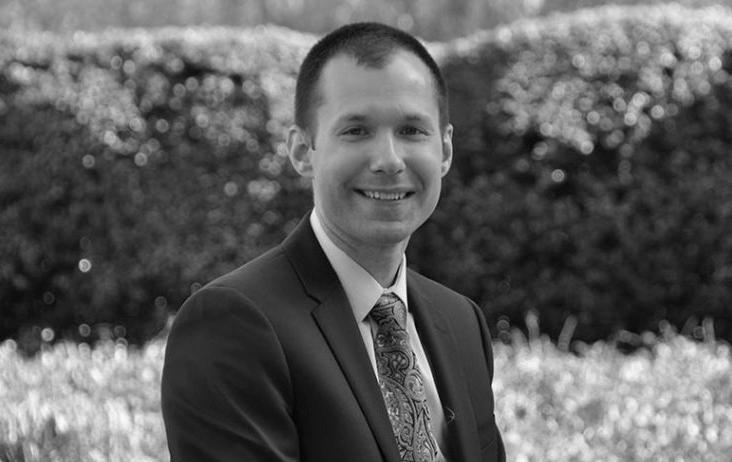
able to contribute a lot based on my past, so I applied for this role and I was selected,” Swinarski said.
Swinariski believes that the vision for the new structure of Fordham’s arts and sciences is a beneficial one.
“I think having one Dean of Arts and Sciences means that we can all work together just for, you know, one person and their vision and their goals. I think it’s a smart move,” Swinarski said.
Swinarksi said that while it is “very busy” and “pretty demanding,” he is enjoying his new role and enjoys getting to meet and interact with students.
“I was in administration once three years ago, but there,
I was working exclusively with faculty,” he said. “In this new job, I’m working directly with students, and that's been a lot of fun and I've gotten to meet especially with a lot of our seniors and hear about all the exciting things that they're doing and planning and that's all … really fun.”
As Fordham adjusts to the new academic advising model, Swinarski says he looks forward to guiding students and faculty.
“I'm really excited about our new structure,” Swinarski said. “Dean Lang has lots of ideas for short and long-term projects and initiatives and I'm excited to bring the experience and skills that I have to help her make those plans a reality.”

Serving the Fordham University campus and community since 1918
The Fordham Ram is the university journal of record. The mission of The Fordham Ram is to provide a forum for the free and open exchange of ideas in service to the community and to act as a student advocate. The Fordham Ram is published every Wednesday during the academic year to all campuses.
Website
TheFordhamRam.com
Email Address theram@fordham.edu
Editor-in-Chief
Nora Malone
Managing Editor
Jacob Wolfer
Production Editor
Sophie Maselli
Editorial Director
Jonah Ring
Multimedia Director
Mary Hawthorn
Business Director
Nishanth Aduma
News Editor
Sienna Reinders
Features Editor
Andrew Massie
Assistant News Editors
Emma Leonardi
Lalleyah Camara
Opinion Editor
Stuart Cremer
Assistant Opinion Editors
Abigail Adams
Loresa Zeqiraj
Culture Editors
Mia Tero
Isabella DeRosa
Assistant Culture Editor
Erynn Sweeney
Sports Editor
Grace McCarron
Assistant Sports Editors
Ian Nelson
James Nelson
Copy Chief
Sarah Verrastro
Executive Copy Editors
Indigo Towers
Emily Tonna
Caroline Lehman
Julia Cholerton
Photo Editor
Meghan Cattani
Digital Producers
Haniyyah Usmani
Molly O’Connor
Hannah Sullivan
Advertising Directors
Jack McDonald
Violet Wallace
Faculty Advisor
Beth Knobel
Editorial Policy
The Fordham Ram’s editorial reflects the editorial board’s opinions or views.
Opinion Policy
The opinions expressed in this publication are those of the authors. They do not necessarily reflect the opinions or views of The Fordham Ram.
Submissions Policy
The Fordham Ram reserves the right to reject or edit any submission for any reason, without notice. Submissions become the exclusive property of The Fordham Ram. No part of The Fordham Ram may be reproduced without written consent.

A government shutdown is almost always a nightmarish event to live through. Vital services and benefit programs are brought to a screeching halt, political tensions become frustratingly inflamed as an endless cycle of accusatory finger pointing begins and countless federal workers find themselves struggling to provide for their family as they are furloughed or out of a job entirely.
Nevertheless, as horrid as life can become during a shutdown, things tend to correct themselves. In fact, the awful state of affairs that arise under a shutdown actually seem to function as an antidote of sorts, effectively imbuing politicians with a sense of urgency to right the proverbial ship with some backroom compromise that brings things back to a state of relative normality.
Yet, this year’s government shutdown just feels different. It simply feels more meaningful — like its consequences will prove to be more dire, like its legacies will prove to hold more weight and like its afterlives will haunt this nation long after we are all gone.
Sadly, it is the opinion of this editorial board that these intuitions — these foreboding premonitions — are perhaps correct and wellfounded. In other words, it ultimately seems to us that this particular government shutdown carries with it more political weight than any of those that have come before it, as it has constitutional and normative stakes that will dictate how this country looks and is governed for years to come.
Take, for instance, the manner in which the Trump administration has handled this shutdown. Instead of responding to this sociopolitical crisis with any degree of political maturity or an attitude that would lend itself to genuinely productive reconciliation with Democrats, President Donald Trump’s White House has instead used this current crisis to
legitimize, and perhaps even normalize, an unprecedented weaponization of its executive and bureaucratic power.
Perhaps most visibly, the Trump administration has dangerously harnessed official governmental channels to engage in a smear campaign full of petty, unproductive and divisive conduct. They have not only used official governmental websites to endorse overtly partisan narratives and frame this crisis as an issue caused by the “Radical Left,” but they have also actively spread disinformation, with Trump himself posting a potentially misleading (and perhaps racist) deepfake video of Democratic lawmakers discussing the shutdown on his official Truth Social account. Moreover, Trump has additionally seized upon the funding lapse caused by this shutdown to justify using various Make America Great Again (MAGA)-controlled bureaucratic agencies and the Office of Management and Budget (OMB) to carry out a series of retaliatory cuts to various governmental programs and initiatives championed by his political opponents. Just here in New York City alone, Trump not only vengefully froze around $18 billion dollars in funding that was meant to go towards a massive infrastructural overhaul of a portion of NYC’s subway system, but he also stripped NYC of its portion of a funding bloc meant to go towards green energy projects. Notably, in both instances, he and his administration very publicly identified the impetus for these rather shocking moves on Democrats’ role in this shutdown. On the other hand, consider the monumental stakes for Democrats in this shutdown. After months of offering up nothing more than fruitless and impotent responses to the Trump administration’s terrifying slide into authoritarian tendencies, they finally have a way of actually putting a wrench into MAGA’s
plans: simply refusing to come to the negotiation table. The formula for fighting back has never been and never will be simpler.
For one, Trump’s political project simply cannot survive a sustained shutdown on the logistical front. To be sure, he can certainly continue to vengefully slash progressive programs, but some of the bureaucratic arms and mechanisms that his administration relies upon to carry out its initiatives will effectively cease to function without funding or staffing. The United States Immigration and Customs Enforcement (ICE), for instance, may soon face hiring delays due to impending logistical shortcomings, while many of the high-profile cases that the Trump administration is actively litigating are slated to be shelved as federal staffing rollbacks, especially in the federal judiciary, get under way.
More importantly for Democrats, however, is the fact that Trump simply cannot optically afford to have the court of public opinion turn against him more than it already has. To be blunt, the reality is that his presidency is already terribly unpopular with the American public under normal conditions: a recent September Quinnipiac University poll revealed that he does not have majority support for any of his major policy initiatives (immigration, trade, the Israel-Palestine conflict, etc.), while his aggregate net approval rating across all major reputable pollsters has consistently hovered around -7.2% in the past couple of months (i.e., around 52% of Americans tend to disapprove of his job performance). A government shutdown, however, is understandably not likely to make anybody view him and his administration more favourably than this, as polls have already shown Americans are prone to blame the party currently in power for the present state of affairs. And should one consider these two realities in light of each
other (i.e., that Trump is already unpopular, and that a government will certainly not make him any more popular), a sustained government shutdown may very well prove to be a breaking point for the Trump administration’s future prospects, effectively pushing them past the point of no return when it comes to the public’s willingness to tolerate anything MAGA.
Considering all this, then, by refusing to come to the negotiating table, Democrats do have a very real, albeit de facto and negatory, way of not just cutting the Trump administration off from the logistical support it needs to carry out many of its unsavory policies, but also the public support it needs to stay in power. However, amidst all these extremely important moving political pieces to this shutdown, one must not lose sight of the fact that all this politicking — whether it’s letting everything crash and burn or weaponizing the shutdown for retaliatory purposes — is going to come with very real world consequences … Real human beings will be the ones to lose their jobs and therefore struggle to put food on the table; just as real families will find the programs that they depend upon to live and unable to provide them with assistance. In other words, to paraphrase the great Ta-Nehisi Coates, one must not forget that this shutdown, with all of its disruption and political maneuvering, is going to come back upon the average American with great violence and great harm. Thus, while The Fordham Ram has no simple answer for how this shutdown should be handled, it nonetheless urges our leaders to not only consider the constitutional and political weight of their actions, but to also always keep an eye towards the real world consequences of their actions. After all, the end goal of a constitutional republic is to provide a civic space where human life can flourish.
When I was a kid, I used to go to my terrace at night and stare at the stars. There was something comforting about looking up at a sky that never really changed, even when everything else around me did. Even now, that curiosity hasn’t gone away. But when I see another rocket launch trending online, I start to question what we’re actually chasing — understanding or just attention.
Lately, the idea of space exploration feels different. It doesn’t feel like discovery anymore. It feels like competition. Every few weeks, there’s a new company sending something into orbit. What used to represent human unity now feels like a contest between corporate giants who can afford to dream in billions. Space has always been ambitious, but now it seems driven by profit as much as progress.
Don’t get me wrong, I think exploring space is incredible. It’s one of the few things that still reminds us of what human potential looks like. But at the same time, I can’t help noticing how much we’re spending to reach farther when we’re still struggling to take care of what’s right here. The world is facing record levels of hunger.
Millions of people still don’t have access to clean water or basic healthcare; climate change is impacting lives every day. Yet somehow, we can always find hundreds of billions of dollars to build rockets, satellites and luxury space flights.
It’s not that space research shouldn’t exist; the technology it creates often helps us in ways we don’t immediately see — in communication, medicine and disaster relief. But I keep wondering how much good that same intelligence and funding could do if we treated problems on Earth with the same urgency. What would it look like if the drive to reach Mars were matched by a drive to feed every child on this planet?
Maybe part of the issue is that space feels cleaner than reality. It’s easier to look up at the stars than to face the mess around us. Rockets are symbols of progress, and we love progress, as long as it looks shiny. But real progress, the kind that changes how people live, often looks ordinary. It’s building schools, fixing systems and making food affordable. Those things don’t trend on social media, but who doesn’t want to watch a rocket launch?
There’s also a strange irony
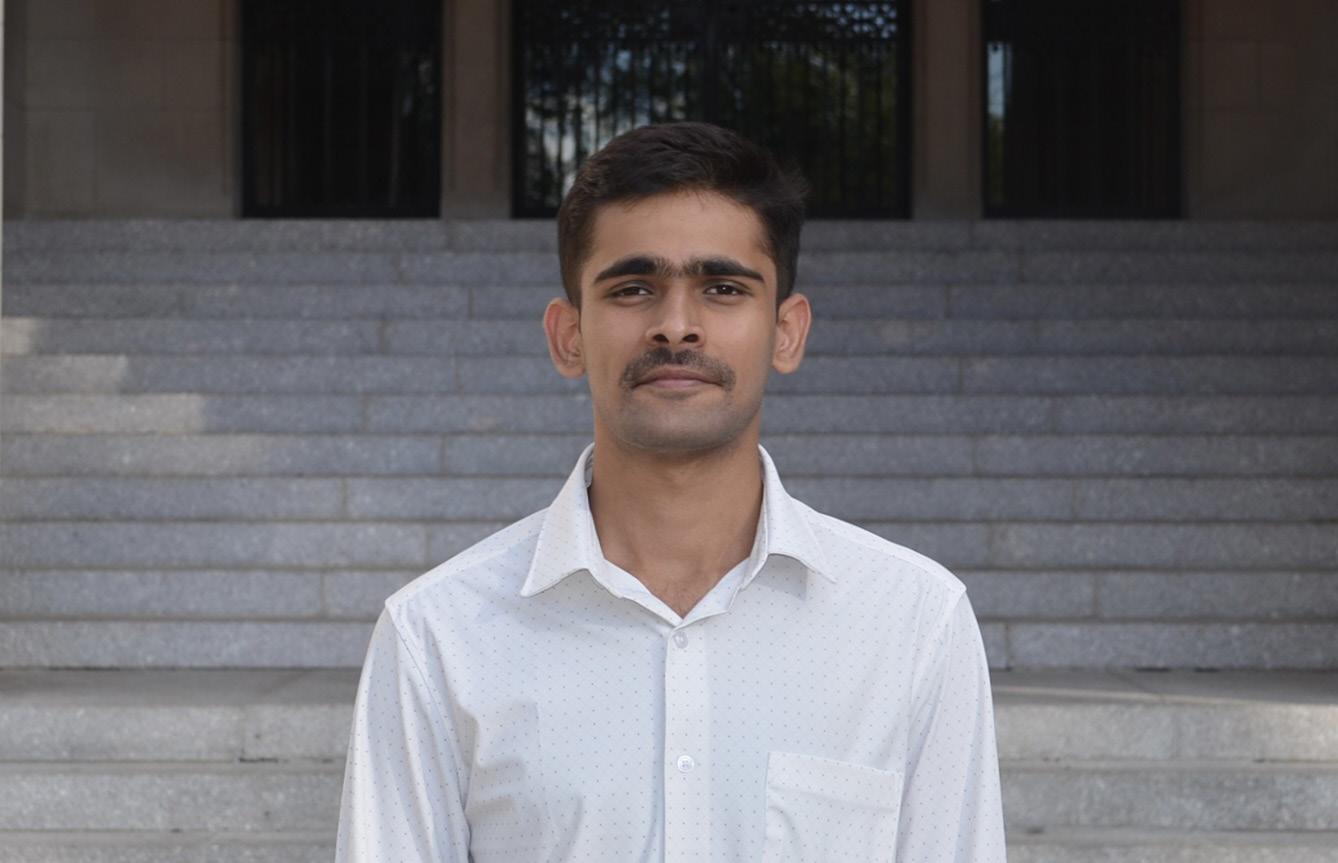
in how we talk about space as the “next frontier,” as if leaving Earth will somehow free us from the problems we’ve created here. But if we can’t solve inequality, greed and exploitation on our own planet, what makes us think we won’t repeat them somewhere else? We could end up carrying the same problems into the stars, just with better equipment. Still, I don’t think the answer is to stop spending on exploring. Curiosity is one of
the best things about being human. But maybe curiosity should come with perspective. Maybe we should learn how to balance our excitement for what’s out there with our responsibility for what’s here. The way I see it, space should be a reminder of how small and fragile life is, not an excuse to escape it. Whenever I look at the sky now, it is still as interesting as it was when I was a kid. However, the stars don’t
just make me wonder what’s beyond us; they make me think about what we’re leaving behind. The universe will always be there. What won’t wait are the people who need help, the forests burning, the oceans rising. If space exploration really is about understanding, maybe that understanding has to start at home. Before we prove we can live somewhere else, we should prove we deserve the place we already have.

By BRIDGETTE LEAHY STAFF WRITER
Let’s talk (mental) fitness. A sensitive topic nowadays. What does it mean to be fit in today’s modern society? Does being skinny, hot or muscular equal being fit? Well, at the end of the day, it’s more than one’s appearance. Personally, I think that the idealization of beauty standards and the expectations of how one should look are significant issues in today’s society, particularly for adolescents and young adults.
I, myself, am a victim of falling for the propaganda that fitness social media pushes. It shouldn’t really matter how other people look, but rather how confident and healthy you are in your own body. However, with various platforms such as TikTok, Instagram, Strava, MyFitnessPal, Nike Run Club and Peloton, it almost seems impossible not to compare yourself to popular models or influencers constantly.
As humans, we are all bound to strive for our highest potential. Now, with fitness apps including social features that provide a sense of community, people are drawn to fitness as a social space. In a way, this is highly beneficial as it motivates more individuals to stay healthy and in shape, while also fostering creativity and self-expression among them. However, I think that we should be careful about how we interact with this social world of fitness, before individuals start feeling “unfit” in this society. Is posting about
fitness going too far? Many people engage with these spaces; 345 million people used fitness apps in 2024, with approximately 55.3% of people aged 16 to 24 utilizing fitness apps. As a young adult growing up with social media, I am guilty of downloading my first fitness app around the age of 16, in high school. I can only remember the tears and constant headaches that roamed inside my adolescent mind. That constant monologue, “I’m not thin enough, I’m not pretty enough, I’m not good enough,” after constantly scrolling through beautiful, slender Instagram models. Roughly 76% of young people use Instagram today. During this time, I started to become significantly invested in and yet insecure about my body after seeing so many individuals posting on social media receiving so many likes and comments.
We are deceived by the dopamine we receive from social media. Dopamine is a feel-good chemical, linked to memory, motivation, mood and attention. When we post something that our family and friends like, it gives us a boost of dopamine; however, when we don’t receive that boost or approval, it can impact our sense of self and adequacy. Social media, in other words, is a “highlight reel,” which only displays the user’s best life and neglects the truth and negative aspects. As a result, this leads to issues with selfesteem, anxiety and fear of missing out (FOMO).
At the end of the day, I was
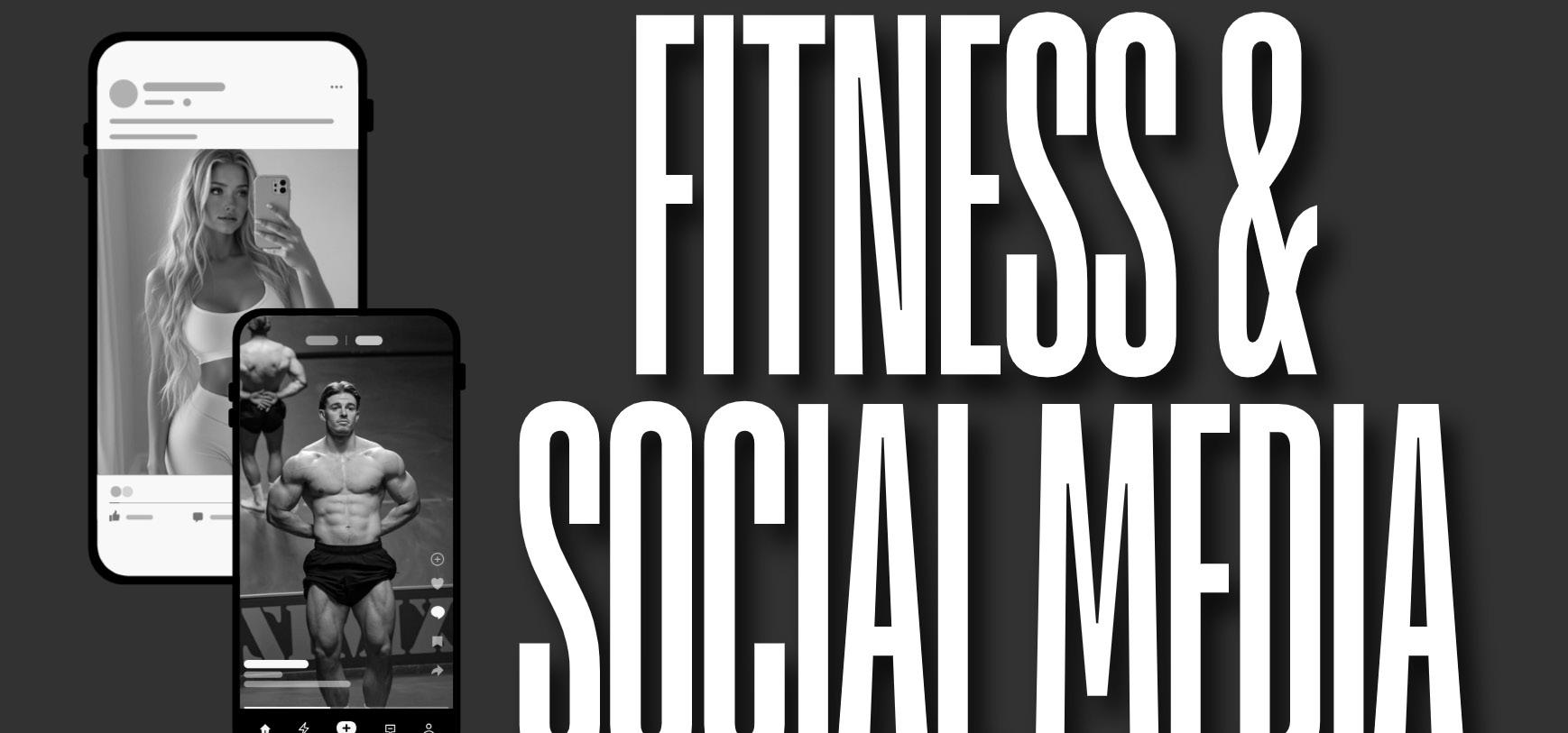
ultimately doing this to feel accepted and like I belonged. I tracked every single food and calculated the net calories I burned and ate each day. Sounds exhausting, right?
That search for your identity and wanting to feel noticed and well-liked is everything as a vulnerable teen or young adult. It was my first time having a boyfriend in high school, so naturally, I wanted him to stay in love with me and admire my looks. It seems silly now, looking back at it, but it is only due to the helpless, young insecure mind. With men, I’ve noticed an increase in influencers abusing steroids to achieve a particular muscular physique. According to PubMed, 54% of all male bodybuilders use anabolic steroids regularly, compared to 10% of female competitors. Studies have examined the various life defects associated with steroids. This remains a vast issue because
we are idolizing unrealistic and unhealthy body types in today’s fitness world.
Through my journey, I’ve come to understand the distinction between being healthy and happy versus merely appearing “healthy” while feeling unhappy. Being healthy and happy isn’t defined by meeting a specific aesthetic, such as a certain weight or clothing size. Instead, it’s about appreciating the body’s ability to move and provide for its own nourishment. It’s about finding enjoyment in food rather than starving yourself and restricting your diet, and exercising in a way helps you feel good. When you try to fit into a specific image of “healthiness,” you can easily find yourself lost and much more depressed, no matter how much you fight it. My best advice is to ensure your body and mind are in sync. Constantly being in a state of fight
or flight mode, pushing away the joys in life, will eventually lead you to fighting for your life or your happiness.
On the bright side, everyone is getting in shape. It’s evident in how we are overcoming unhealthy habits and saving money by creating community through these fitness apps. With the right mindset, fitness apps do lead to positive results, boosts in confidence, flexibility, motivation, guidance and a sense of support.
In conclusion, it’s essential to redefine what fitness and health mean to you, focusing on personal happiness and well-being rather than social expectations. Learn how to love your body, and stop this constant self-hatred. If I did it, then I’m 100% certain you can. It’s never too late to break a bad habit.
Bridgette Leahy, FCRH ’27, is a journalism major from Basking Ridge, New Jersey.
By EMILY MITTON CONTRIBUTING WRITER
When applying to Fordham University, I noticed that a main slogan and source of appeal to apply to the university was that, “Fordham is my school, New York is my campus.” I am certain that if you attend Fordham, you have heard this slogan an abundance of times. When actually considering if this saying is true, I would wholeheartedly answer with yes.
Whether you attend the Rose Hill campus in the Bronx or the Lincoln Center campus in Manhattan, Fordham provides a lovely place to study, take classes and make friends. Due to the locations of Fordham’s campuses, however, this is not all that they provide, as it offers the city at your fingertips. Between Fordham-held events and individual exploration, New York City is always waiting for students to go out and explore it.
One great example of how Fordham integrates its students into New York is through its amazing internship opportunities. As Fordham’s Internship Promise says, “Every Fordham
undergraduate student will have the opportunity to land at least one internship, including research and other experiential learning.” Due to this promise, students have the amazing advantage of being able to land a highly rated internship in a prime location: New York City. Whether you’re an American Studies or journalism student, you can secure an internship anywhere in the city and, in turn, further explore how you can make the city your campus.
Yet another advantage of Fordham with the city as our campus is how convenient it is to venture out into the city. Whether you want to explore the borough that your school is in or travel to a different one to see the beautiful sights there, there are abundant options of public transportation, including the Ram Van, to make it happen. Taking time to explore the city is a surefire way of making it feel less like a foreign place and more like your home.
While exploring New York City is, for most, an extremely appealing aspect of attending Fordham, I am sure many
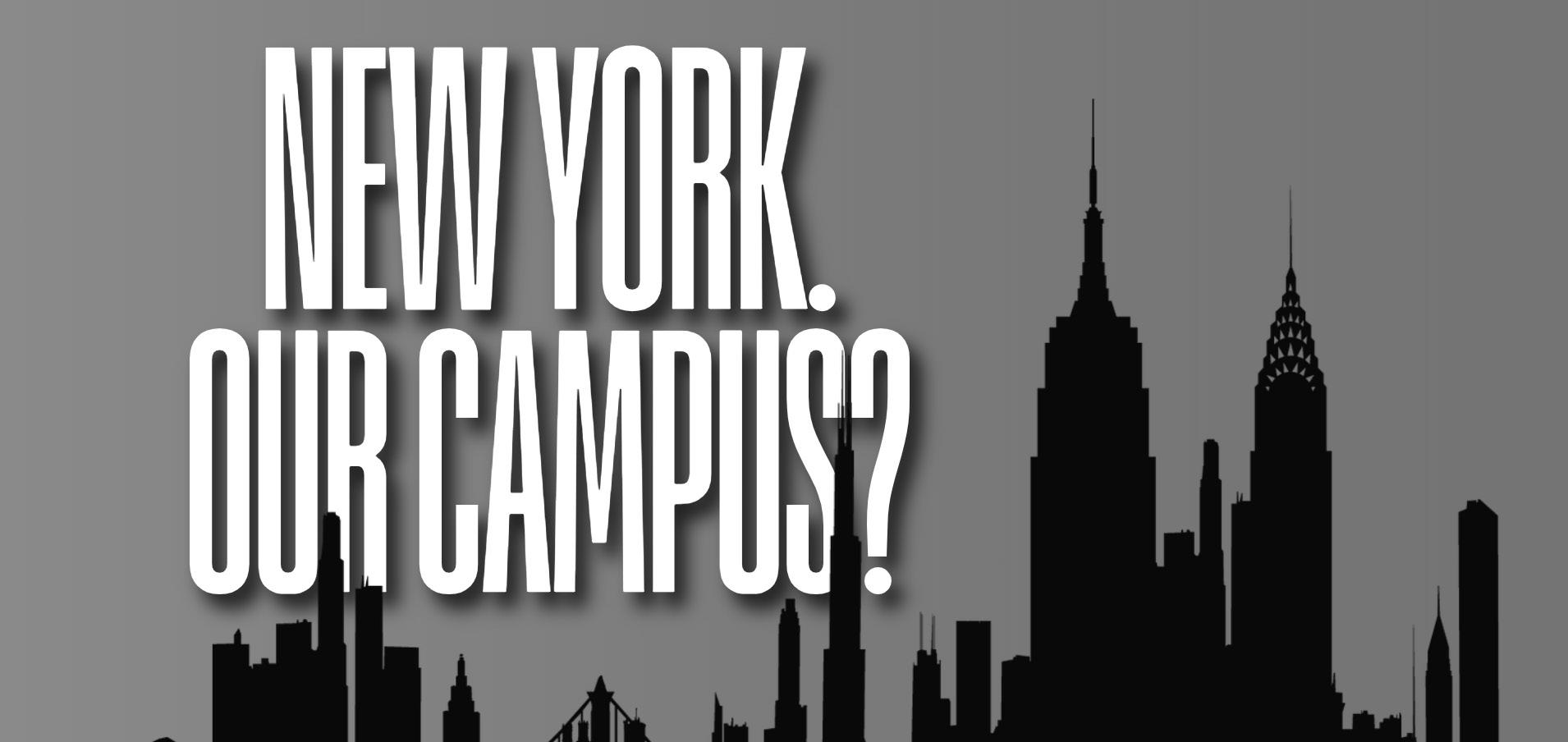
Attending university in New
students have still found that it is difficult to make time to explore everywhere that one wants to. Therefore, I would love to suggest some ideas for how to still go into the city and explore while having time to complete all of your assignments!
To begin, a great way to explore the city and get work done is by bringing your studies outside of the campus. If you attend Rose Hill, for example, taking Metro-North to Grand Central will bring you to an abundance of excellent places to study,
such as the New York Public Library and Central Park. Another great way to explore the city in a time crunch would be to simply go on a timed walk around a few blocks of a new area. This way, you are getting exercise, taking a break from studies and seeing a new part of the city all in one. I personally feel that having New York City as your campus, as Fordham coins, will only fulfill itself with as much effort that you put in for this to be true. While it can be tempting to remain in the
MEGHAN CATTANI/THE
comfort of campus and enjoy all of the wonderful events and activities it has to offer, it is equally as important to branch out and explore different parts of the city due to our proximity. The initiative that each student puts in to make New York City their campus will determine how they feel about the accuracy of that statement.
By CAITLIN WONG CONTRIBUTING WRITER
Dimethyltryptamine (DMT), Lysergic acid diethylamide (LSD), Methylenedioxymethamphetamine (MDMA) and psilocybin, also known as “magic mushrooms,” are a few somewhat commonly known psychedelic drugs. The label “psychedelic” refers to their shared ability to warp and distort the user’s perception of reality. The usage and possession of these substances are illegal under the Controlled Substances Act, as they are considered Schedule I drugs. Just to drive home how these drugs are treated: Schedule I substances, under federal law, have no recognized medical benefits while having severe and dangerous potential for abuse and addiction. The aforementioned psychedelic drugs all rank above drugs such as OxyContin, fentanyl and methadone in severity, as they fall under Schedule II due to their approved medicinal uses.
In recent years, many states have legalized and highly decriminalized the usage of marijuana, some just for medicinal purposes, but others for recreational usage as well. Starting in 2020, Oregon legalized the licensed permitted use of psilocybin in a therapeutic, clinical setting. As of 2025, Colorado is issuing these licenses as well. Several other states have moved to decriminalize and legalize the controlled usage
of psilocybin, but are still in the process of doing so. As stated before, the medical relevance of the substance has much to do with its legalization, yet many are not convinced of the benefits of “psychedelic therapy.” In no way has psychedelic therapy become a popular or even somewhat common treatment for mental health disorders, but clinical trials have shown some positive results in people with treatment-resistant depression and post-traumatic stress disorder patients who do not respond to the most common antidepressant, Selective Serotonin Reuptake Inhibitors (SSRIs). As a psychology major and someone who has been prescribed several antidepressants, I know these SSRIs — which are practically the first thing prescribed to patients with depressive symptoms — take up to weeks or months in some cases to begin working because the brain is rebuilding neural connections and literally changing the functionality of its synaptic receptors at a cellular level. Even beyond the chemical component, the body takes a while to “recalibrate” the change. Scientists have begun recognizing that these same synapses, the place where neurons communicate through neurotransmitters, are rebuilt and healed more rapidly when dosing with psychedelics. Patients with severe depression could receive far more immediate relief from symptoms if this

hypothesis proves to be true. I also believe that as more research is done, more states will come to legalize its medical usage, possibly to the point where it can be prescribed for outpatient use.
However, I have a lot of fears and concerns surrounding the potential mixed legalization of psychedelic drugs used to treat depression, such as MDMA and psilocybin. Since my AP Psychology class during my junior year of high school, I have been taught that all forms of medication, including SSRIs, work best when the patient is consistently attending therapy while on the medication. For psychedelics, this is only more true. Due to the intense effects of these drugs, from causing hallucinations to extremely heightened emotions to increased empathy, it is in the best interest of everyone’s safety that the administration of the drug occurs in a
controlled environment. It is also important to have a physician there for the patient to talk to, since the experience the patient is having can be very insightful towards the root causes of their depressive disorder. The goal should not be to keep a patient dosed with psychedelics at all times. Without that aspect of having a qualified observer to have a grounded and objective perspective on what the patient is experiencing, mentally and emotionally, the entire process could lose its medical benefits after the drug wears off. I believe it will work best as a therapeutic and interpersonal tool. Should drugs used in psychedelic therapy follow the same path to legalization as marijuana, people may begin to believe they can self-medicate without medical supervision. Without a trained practitioner around,
there are real and dangerous risks involved when using psychedelic substances. There is even a chance that the usage of these drugs at home could worsen symptoms without a medical professional present, since many will have bad experiences with extremely negative emotional outcomes and reactions. If there is no chance for inferences toward treating the patient effectively to be made during the trip, there are far more risks than the chance for benefits. It will be an interesting legal tightrope to cross to balance the medicinal benefits of psychedelics with protecting patients when they are outside of care, and I hope further research continues to occur all over the country.

By AUDREY BOLDS CONTRIBUTING WRITER
The Fordham University football program isn’t really worth more than its financial cost. Despite having 102 football players on the roster this season and a coaching staff of 17, including both paid and unpaid positions, this team has continuously struggled to deliver results. Their last
winning season was in 2023, with a 6-5 record. While the program should be kept for the sake of tradition, I believe it is time to reduce its funding and redirect resources to better serve the wider student body. After a loss to Lafayette College on Oct. 4, the Fordham Rams sit at 1-5 this season. The team managed a narrow win against the College of the Holy
Cross on Saturday, Sept. 27, with a score of 26-21, reclaiming the Ram-Crusader Cup, a tradition dating back to 1951. But last year’s 2-10 record suggests yet another disappointing finish is likely. Regardless, the program continues to draw revenue from ticket sales and donations.
The financial picture isn’t much brighter. According to College Factual, the football program brought home $7,833,065 in revenue in 2024, the exact amount it spent on expenses. In other words, Fordham Football broke even, neither losing nor making money. Breaking even is better than losing money, but it still means millions of dollars are consumed by a single team, with little return for the majority of students.
Head Coach Joe Conlin’s salary is not publicly available, though his contract is speculated to be around $300,000 annually. For comparison, Fordham’s 2024 IRS Form 990 revealed that the now-fired head basketball coach Keith Urgo earned $1,047,652, making him the university’s second-highest paid employee that year after President Tania Tetlow at $1,516,067. The football
program may not technically lose money, but it requires a large investment with little return for the student body.
The disconnect between the program and students is clear. Multiple upperclassmen at Rose Hill say they have never attended a football game. “I don’t see the point,” said Fatma Matope, GSB ’27. “I’m not going to spend more money on top of tuition and textbooks to watch an uneventful game.” The majority of students I spoke to said they don’t plan on going to any football games this year.
Layla Fleming, GSB ’27, said that she attended a game as a first-year, but never returned.
“The games remind me of my high school games, I think my [high school’s] junior year team could beat Fordham,” she said. While she noted that the free merchandise and on-campus events were fun, they were not enough to bring her back.
It is true that Fordham Football has a proud history. Vince Lombardi, FC ’37 played for the Rams from 1933 to 1936, leading the team through a 25-game winning streak and helping form the iconic “Seven Blocks of Granite” defensive line. However, those glory years were 88 years ago, and
the program has not come close to that level since. History alone cannot justify a program that few students care about and that no longer elevates the university.
If Fordham insists on keeping their football program, it needs a financial diet. Resources could be redirected towards academics, scholarships or student services that benefit the wider campus community, rather than a small group of select athletes. Fordham already has many strong traditions — the President’s Ball, Winter Ball, Spring Weekend, riding the Ram, the Candlelighting Ceremony and more — that unite students together in ways football no longer does. Some do argue that football is a cornerstone of Fordham’s school spirit and identity. While it certainly contributes to campus culture, clinging to a fading legacy should not come at the expense of the university’s future. Fordham’s spirit does not have to rest on a program that consistently underdelivers both on the field and off it.
By ETHAN BESS
WRITER
In 2021, New York City was in crisis, just coming out of the wake of the pandemic. The mortality rate was dropping, but the hospitalization rate was still high. Rent on average was about $1,680 per square unit, and New York was struggling with childcare costs. However, as most New Yorkers were aware, there was an election to be held on Nov. 2, 2021. The main candidates were Eric Adams, the Democratic nominee, and Curtis Sliwa, the Republican nominee. Adams, who was the self-proclaimed “new face of the Democratic Party” campaigned on bringing a “new vision” to NYC that included tough-on-crime policing and economic revitalization. He torched Sliwa in the general election and received close to 67% of the vote. Now, four years later, we must look at how his term has transpired and the causes of his dropping out.
At the time, I was skeptical of Adams, and I felt that what he was promoting would run New York City deeper into existing issues. Where that train of thought came from was people not knowing who he
was or what he stood for. Is the Adams administration responsible for all of New York City’s problems?
Of course not, but it is the epitome of them, and it has intensified many of our problems as the years have passed by. For example, over the last three years, Adams has cut over $400 million from childcare programs that were mainly skewed towards preK and K-3 initiatives. Many of these cuts were crucial in driving kids out of school, and his administration faced harsh criticism as a result.
Why exactly would one cut so much money in terms of a program that was working, and many kids and parents relied on? Adams eventually justified this by saying some of the money wasn’t being utilized; however, this was still met with significant backlash from New Yorkers.
Furthermore, I believe it’s important to turn to another part of Adams’ problems: his bribery scandal involving the Turkish Embassy. At first, Adams denied wrongdoing when the FBI seized his electronic devices in November of 2023. However, as more information came out, it started to spell trouble for Adams, culminating in a federal indictment
in September 2024 and making Adams the first sitting mayor of NYC to be criminally charged. How can a city of citizens trust their own mayor to represent them when he is taking bribes from a foreign government? It’s a question that was and still is on the mind of many New Yorkers like myself. By the beginning of October, many New Yorkers were calling for him to resign amidst his approval ratings falling as low as 26%.
If Adams was the “new face” of the Democratic Party but has failed so abysmally, it begs the question: Is the old guard of the Democratic Party out of touch with people, especially the youth? I believe so. Ever since the Democrats’ losses in the 2024 elections, partially because of declining support among youth, they have been scrambling to find a way to rebuild their coalition. Adams, like the other former Democrat and now-independent mayoral candidate Andrew Cuomo, comes from the old guard of the Democratic Party, emphasized by his moderate political positions and his connections to high-ranking New York Democrats such as Rep. Hakeem Jefferies

and Sen. Chuck Schumer. Adams’ politics may have worked back then, but they won’t win you a lot of support from New Yorkers now. Adams has even said, “I didn’t leave the democratic party, the democratic party left me,” a quote that only stoked his unpopularity. What many New Yorkers want is not words and promises; they want actions that speak to their needs, particularly the need for affordability. It’s why the new Democratic nominee for mayor, Zohran Mamdani, has been able to rise through the ranks and become a star in the world of Democratic politics. He is
someone who speaks to working people, talks about fighting President Donald Trump’s policies against New York and about a New York City that can work for all, not just the few. Mamdani’s vision is another reason I believe Adams dropped out — because he could not take the heat of someone young and vibrant. Adams’ leaving the race only makes it slightly less contested. New Yorkers are still deciding whether Mamdani, Cuomo or Sliwa will be their next mayor.
Ethan Bess, FCRH ’27, is a media and television studies major from Roanoke. Texas.

By CATHERINE PAYLEITNER CONTRIBUTING WRITER
in March 2024 — launching numerous apparel products, including watches and shoes, as well as multiple cryptocurrencies, one of which has increased the family’s wealth by $5 billion. Trump has turned the presidency into a personal brand, becoming less of a commander-in-chief and more of a content creator.
The most recent venture is from Kai Trump, the president’s granddaughter. She recently launched merchandise with promotional photos taken at the White House. She then posed next to Trump as he answered questions for reporters on Friday, Sept. 26, while wearing one of the pullovers — and again that weekend at the Ryder Cup.
moment came conveniently for the company, as Tesla’s stock was going on seven consecutive weeks of losses. It was their biggest plunge since debuting on the Nasdaq in 2010. The event was also livestreamed on the social media site X, which Musk purchased in April 2022. More recently, Trump has discussed the possibilities of hosting Ultimate Fighting Championship fights in 2026 to celebrate America’s 250th anniversary.
when it comes to holding office. He blatantly ignored ethical standards when he cast aside vetting procedures for his Cabinet picks and laughed at the idea of him and his children having conflicts of interest. These conflicts have gotten so out of hand that watchdogs maintain running lists to keep track.
“Crony capitalism” is a term that has been thrown around increasingly in recent months as President Donald Trump’s administration has taken office. The MerriamWebster dictionary defines it as an economic system that allows individuals or businesses with political connections to have a favored influence that can suppress open competition in a free market. In theory, that’s a warning. In practice, it’s a business model and the Trump family is its most enthusiastic case study. Trump’s second term has turned the White House into a marketplace for personal and political gain, exemplifying the dangers of crony capitalism. Because of this, he has irrevocably damaged the integrity of the office of the President of the United States.
In July 2025, a New York Times investigation exposed that “[h]is lower Manhattan office building generated too little cash to cover its mortgage” and his golf courses regularly failed to cover costs due to lack of players. Trump has also faced tremendous legal fees because of his criminal trials and hundreds of millions of dollars in civil lawsuit penalties. Faced with mounting financial pressure, the Trump family has consistently rolled out new business ventures since clinching the Republican nomination
Kai Trump’s logo has sparked controversy as it resembles a logo used by American Eagle x Tru Kolors collaboration. Tru Kolors is the clothing brand of the Kansas City Chiefs’ starting tight end Travis Kelce launched in 2019. His logo has remained consistent throughout the brand’s existence. While neither brand has taken any legal action, many people online have cited copyright laws supporting Kelce and American Eagle.
This is not the first time that Trump has used the White House to promote his personal interests. In March 2025, he transformed the South Lawn into Elon Musk’s Tesla showroom in a private event. This
When the White House becomes a backdrop for brand promotion (familial or otherwise), it’s not just unethical; it chips away at the foundation of presidential integrity. The Constitution designates the office of the president to serve the public interest, not private gain. When Trump leverages the prestige of the White House to elevate specific products, he blurs the lines between governance and self-enrichment. This behavior erodes public trust and signals a dangerous shift where those in power treat the presidency as a personal billboard. Frankly, I wouldn’t be surprised if they went so far as to install billboards on the White House roof.
The president should not use his position of power for personal benefit, but Trump has shown that he does not care for the rules or morals
However, since all three branches of government are controlled by Republicans, the checks on Trump and his support for crony capitalism are few and far between. It’s hard to believe this is the same country that condemned former President Jimmy Carter for having a peanut farm before his term began in 1977. Somewhere along the way, the ethical bar for presidential conduct collapsed, and now our government seems to be overrun by shady businessmen disguised as politicians. If we accept this erosion of ethical boundaries at the highest level, what does that say about our own standards for leadership? As students, voters and future leaders, we must demand transparency from our government and ourselves.
By UMA PETZKE CONTRIBUTING WRITER
“What are you going to be for Halloween?” is the question that has been brought up in nearly every conversation since Oct. 1. The discussion of what to be for Halloween is a top priority for everyone looking to put their best foot forward on Halloweekend. Personally, I am still back and forth between a few choices with Betty Boop, Amy Winehouse and a bunny all top contenders. However, I have yet to purchase anything in my Amazon cart. None of these choices are very original, but they are each from a different category of Halloween costumes.
Betty Boop, a classic character from the 1930s, is timeless with a low effort outfit; just a little red dress, heels and good eye makeup are all you need. There are countless classic Halloween costumes like Fembots, Little Red Ridinghood, Alice from “Alice in Wonderland,” any of the Disney princesses and so many more. The classics will always look cute, and there are so many ways to make them uniquely your own. Whether its signature makeup, making a lovable childhood character haunted or just accessorizing in your own way, the classic costumes are always a safe bet for being recognized and getting good
photos with your friends.
Amy Winehouse is a historical figure who is famous for her voice as well as her signature look: big hair, tattoos and too-thick eyeliner. She is a popular icon and makes for the perfect Halloween costume that is both recognizable and unique. Choosing to dress up as a celebrity can be difficult, though, as it’s less generalized compared to the classic costumes. Making yourself look enough like someone else is hard to do, but as long as your costume has enough hints you’re safe. My TikTok feed has recently been overwhelmed with “Fight Club” costumes where duos dress up as Tyler Durden. This is a perfect example of a costume with enough cues that it is easily understood. Marie Antoinette, Cleopatra, Kris Jenner, Britney Spears and Jojo Siwa (hoping not to see this) are all under the same umbrella of costume. A person so famous that they are immediately identified. Finally, a bunny is the perfect costume for the last night of celebrating. Easy, simple, quick and still cute. A bunny, leopard, mouse, polar bear, cat or any other furry creature is perfect and can be accessorized by adding a Beanie Baby tag or ear headbands. Choosing an easy costume may be less creative than the rest, but in my
opinion it’s perfect for the final night of going out. There are so many ways to impress with costume choice on Halloween and no matter what kind of costume you choose there are even more ways to make it your own. Looking for inspiration can be the most fun part of the process. I have had a Pinterest tab open for the past week saving all the ideas that come up on my homepage, and somehow I am already seeing TikToks
with ideas I never could have come up with on my own. Costumes based on drinks, emotions, seven deadly sins and childhood story characters have been some of the most fun to see. If your goal for Halloween is to have an “underground” costume then I can recommend looking back in books and stories from your youth: “The Girl with the Green Ribbon,” “Fancy Nancy,” “The Rainbow Fish” and “If You Give a Mouse a
Cookie” could all be fun ways to put a spin on some classic costumes.
The culture of Halloween in college is one of the most common tropes in movies for a reason: it’s all the glitter, glam and fun that people have been waiting for. Halloweekend is the light at the end of the tunnel for a lot of us during midterm season and nothing is better than planning out the perfect costume to celebrate.


By EMILY MCCALL CONTRIBUTING WRITER
Beginning on Sept. 26 and lasting until Oct. 13, Lincoln Center is hosting their 63rd annual film festival. The New York Film Festival has become a highly anticipated event since its start in 1963 by Richard Roud who worked at the London Film Festival, as well as Amos Vogel who had previously worked with Cinema 16 Film Society. Only four years after its start, Film at Lincoln Center (FLC) was founded as a nonprofit organization dedicated to preserving and showcasing films from all different parts of the world as well as different time periods. Now, the two work together to put these great films together in one location for all to enjoy.
This year, the festival showcased almost 100 different films ranging across 35 different languages and spanning 96 years of production. Some of the most anticipated films included “Mr. Scorsese,” “The Arch,” “I Only Rest in the Storm” and “The Razor’s Edge.” Each film offered multiple showings with tickets priced between $20 and $30, allowing people a chance to enjoy these hard to find films on the big screen. For anyone interested in film, writing, history, art, makeup, set design and so much else, this is the
perfect option for a quiet night out. With all of the options available there was something for everyone each day of the festival.
Taking full advantage of this opportunity, I chose to attend the 1929 silent film “Queen Kelly” directed by Erich von Stroheim. Going into it, I was apprehensive. I have never watched a silent film before and I worried that due to being made almost a century ago, it would be too outdated, causing it to be difficult to relate to or understand. Even still, it was the only film that I could fit into my schedule, so I decided to give it a chance. Prior to going I had researched the plot but somehow missed the fact that the movie, the one von Stroheim believed would be his best work, was never finished.
The beginning of the movie was well produced, and even with my lack of expertise in this style of film I could tell it would have been a classic. At the end, however, certain scenes began repeating just with different words, and in some, there was only a still image. After the incomplete ending a short description of what would have occurred after appeared on screen. The runtime is 106 minutes, but based on the script, it is believed that the original movie would have
been closer to five hours. The chances of a movie like this getting the opportunity to be shown in a theater nearly 100 years after being partially made are incredibly unlikely, which is why I feel so lucky to have been able to witness it at the New York Film Festival. From what I was able to see in the film, I realized the reality is that people have not changed much since the time it was made. The movie, as far as I could tell, was an early 20th century version of a romantic comedy — a highly popularized genre. There were certainly aspects of the plot and characters that are no longer as acceptable in modern times, yet I still found myself able to understand and appreciate the many jokes and humorous moments throughout. Silent films and black-and-white films are not as archaic as I had been expecting.
Had I not known about the New York Film Festival and decided to see this specific film, I do not know if I ever would have been exposed to the artistic beauty of silent film. Since there were rarely titlecards, the actors had to show everything with exaggerated acting and expressions. I felt so much more emotion than I would have if the characters had been talking. The slow-paced scenes alongside
instrumental music made it quite peaceful — something that we do not get a lot of in modern media that is full of rushed scenes, loud talking and trending lyrical music. I walked into the theater not knowing what to expect and
left with a new understanding of film and the power it holds. As someone who is only just beginning to explore New York City on my own, this experience is one to remember as well as something to look forward to for next year.

By JULIA BURNHAM CONTRIBUTING WRITER
Some people have very black-and-white views on listening to music while working. They either love it and swear by it or claim it is their Achilles’ heel. Personally, I have always had a more in-the-middle take on it. While I have always been a music lover singing and dancing since I was three years old, I have had an up-and-down relationship with listening to music while I worked. Despite this, my study journey has led me to love listening to music while I work.
During middle school and part of high school, I found it “cool” to listen to artists I loved — for example, Frank Ocean — while I did homework, even if their intricate lyrics (looking at you again, Frank) made it harder to focus. However, everything changed when I discovered the YouTube lifestream, “lofi hip hop radio | beats to relax/ study to.” This continuous 24-hour livestream cemented my love for simple instrumentals while I worked. It made me realize that instrumental music works best for me, whether it’s ambient, classical or my personal favorite, lofi. I hyperfixated on the lofi hip-hop genre for a year in seventh grade
because of this livestream, and I have no regrets.
Even though I mostly listen to the same few tracks, such as the livestream, I also have specific playlists I listen to for different study vibes as well. For example, during finals, Spotify’s “Intense Studying” playlist provided the perfect backdrop for me to have complete silence in my brain. I appreciate listening to that kind of music when I need to shut off any background noise and just work for five hours straight. Other times, when I’m doing low-key readings, I put on the Spotify radio for Leon Bridges’ “Texas Sun” to help cultivate a calm vibe in my apartment.
Even though I have Lofi Girl as my Ol’ Reliable, I can definitely switch my music up depending on the vibe. To sum it up, when I need to have a focused session, I’ll put on instrumental music like lofi or classical, but when I’m only doing light work, I can listen to anything.
Overall, I think music, or background noise in general, while studying is a very helpful tool when used correctly. Music has helped me write essays due at 11:59 p.m. in an hour. Music has helped me get myself together to do an assignment after having a bad day. Music has helped me relax and do a reading
before a fun night out.
It can easily derail your focus if you listen to something with distracting instrumentals or lyrics, but setting the intention of focus with a soundtrack can be the best thing to have a great study session. The sounds can also be relaxing and put you in a better mindset to work, if you listen to something peaceful after having a stressful day.
I completely understand people who need complete silence while they work, but in their case, I have heard brown and pink noises are good for
focus. So if you’re not into actual music while you work, you might just want something to drown out anything in the background. In my experience, I found that brown noise helped when I tried it. Once again, an important caveat to this article is that I am definitely biased in this area as a music lover. I’m someone who prides myself on my music taste, as well as being able to listen to every genre of music and enjoy it (yes, even country). Therefore, my take on listening to music while studying is going to be extremely positive,

Who’s That Kid? | Leah Renshaw FCRH ’27
as someone who is always listening to music, sometimes even writing and singing it. However, apart from my own interest in music, I do truly believe in its healing power. For me, that applies whether it be during profoundly difficult times or simply trying to finish a midterm paper. So if you’re stubbornly set in your ways about only studying in complete silence, maybe this is your sign to try something new and listen to some music (or ambient noise!) while annotating your next article or completing your next math problem.

By MIA TERO CULTURE EDITOR
While most college students are juggling classes, homework and perhaps a part-time job or internship, Leah Renshaw was juggling something a little … magical. The Fordham University junior spent eight months in the Disney College Program. Yes, this means she lived and worked at Disney World — something straight out of a childhood dream.
Applying to the program is a long process. “The Disney College Program is like an internship, but it’s also kind of like an audition,” Renshaw explained. “I attended a few auditions and did a phone interview. It’s a very long process, but once you get accepted, they place you in a specific role within the parks.” Renshaw took a leave of absence from Fordham to participate in the program. Fordham did not offer credit for the program. “I think I was one of the first people to do it from Fordham,” she said. “Most colleges will give you credit for doing it as a paid internship. But Fordham did not, so I had to take a leave of absence, and it was
totally worth it.”
The program isn’t just about work, though. Students also take classes while living in the parks, allowing them to stay on top of their schoolwork while gaining hands-on experience. For Renshaw, this was a no-brainer. As a film and television major, the chance to work at the leading company in that field and connect with professionals as well as other individuals who love Disney was more than enough reason. She even got to meet famed actor John Stamos!
What exactly did Renshaw do at Disney? Of course, some of what happens behind the castle doors is strictly Disney confidential, but she shared that most of her time working was spent on stage and even worked as a waitress in a cafe. “I worked a lot on stage in Magic Kingdom specifically, and it was the coolest. I also did a lot of moneyrelated things when I wasn’t working on stage,” Renshaw explained.
And yes, the hours were intense. She often worked 50 to 60 hours a week, but for Renshaw, this was nothing compared to the joy she got to see on people’s faces. “The
way I was able to overcome it was I just kept telling myself that people save a lifetime to come to Disney World, and I get to be here every day, and I get to be a part of making the magic for these families,” she said.
Renshaw’s love for Disney didn’t start with the program; it’s been with her for her whole life. Renshaw grew up visiting Disney World once or twice a year. “It had such a special place in my childhood, and I have so many memories. So yeah, and I’m definitely still a Disney fan. I come all the time,” she said. Looking ahead, Renshaw hopes to return to Disney in a full-time role after graduation. “I love working for this company and all the leadership was really incredible,” Renshaw said. “The connections are amazing, and it’s one of the biggest in the world. So I would absolutely love to come back.”
Even after leaving the program, Renshaw keeps her Disney connection alive. She still visits friends from the program and continues to gain free access to the parks. For Renshaw, the program was more than a job; it was a chance to combine her love
for Disney, her studies and real-world experience in a way that only a few people have the opportunity to do. While the Magic Kingdom
may be over a thousand
away
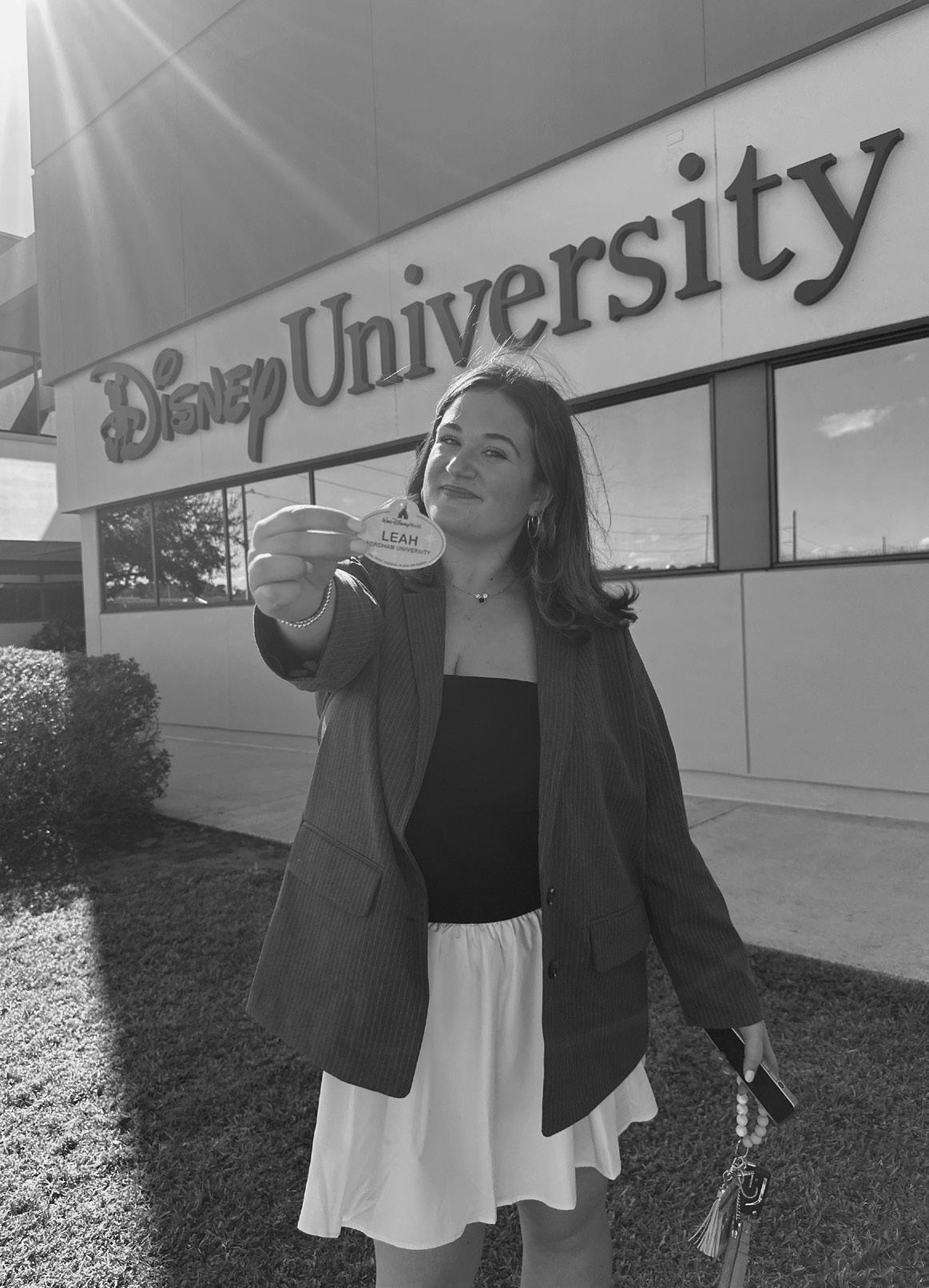
By KATE HERBERT CONTRIBUTING WRITER
According to Traditional Chinese Medicine, autumn is known as the “season of grief,” as it is the natural season of change and letting go, from the leaves slowly dying to the world preparing for the stillness of winter. No novel captures the complexities of grief quite like “Lucy” by Jamaica Kincaid, published in the fall of 1990.
When we think of grief, we usually think of sadness and loss, but often, grief is messy and tangled, reflecting the fickleness of the most profound relationships. Even the famous quote “grief is love with nowhere to go,” written by Jamie Anderson, which is often brought up in conversations about loss, fails to truly capture the ways in which Lucy’s grief sits sharply within her chest.
Lucy is a 19-year-old woman who moved to the United States as an au pair from one of the Caribbean islands, presumably Antigua, where Kincaid was born. Lucy grew up with British colonialism reshaping her culture and thus became very aware of the ways in which her identity had been forced upon her rather than being organically created by her, leading to a seemingly everlasting struggle to define herself. Her mother is the main source of
her grief and the reason for her deep desire to leave her home and never return. Written in first person, this book is a recollection of Lucy’s experiences starting with her initial move.
In the United States, Lucy stumbles through her relationship with her host family, specifically the host mother, as well as her romantic relationships, as she cannot seem to understand or create an all-encompassing definition of love. She harbors immense anger toward her mother — the only person who raised and cared for her — and is unable to function without thinking about her childhood. Her anger and sadness toward her mother evokes a fear of love within Lucy, as she describes, “I didn’t want to love one more thing in my life, didn’t want one more thing that could make my heart break into a million little pieces at my feet.” She moved to the United States to escape her mother yet is still caught, unable to think about anything else, even thousands of miles away. Her grief hangs onto her and forces itself into a lens through which Lucy sees the world.
Kincaid allows Lucy to reveal her story backwards, setting up the reader to grasp onto Lucy as a character before understanding why she truly is the way she is. The

novel never fully explains Lucy’s childhood outright, but uses poetic yet sharp language to invoke the emotions Lucy felt growing up onto the reader. Lucy’s interesting mix of naivety and blunt emotional intelligence is what makes her thoughts and interactions so engaging. With empathy and strength, Lucy states, “The anguish on her face almost broke my heart, but I would not bend,” illustrating her heartbreak simply and directly. Lucy herself is a personified juxtaposition in every aspect. At times, the novel can be overwhelming and vague with
certain sections reading almost like a string of vignettes. As irksome as it is to wish for more detail or explanation about a specific situation Lucy describes, her vagueness is a representation of the sharp turns and unpredictability that come with grief. Lucy is a bouncy character, moving from situation to situation rapidly, yet, at the same time, can also become obsessed with certain moments, reflecting her inner battle with herself. Her grief is sweeping as well as seemingly limitless, and her confusion and curiosity for her new home and new possibilities for life
ultimately contribute to her growth.
Growing up on an island in the Caribbean, Lucy didn’t experience typical seasons as Americans recognize them and thus becomes overwhelmed at each new one that comes her way. Kincaid does an excellent job of mirroring Lucy’s emotional states in the seasons, with the coming of autumn reflecting her disillusionment and surrender. In the season of change and letting go, “Lucy” inspires the reader to hold the door open to grief instead of shutting it away.
By JACQUI LYSON CONTRIBUTING WRITER
Every time I take a trip to The Metropolitan Museum of Art (The Met), I find myself gravitating towards the iconic Impressionist landscapes. From Vincent van Gogh to Claude Monet, I have always stopped at their pieces first on my journey through The Met. This time, however, after climbing the iconic staircase, I stopped in the Drawing and Prints room to look at the new exhibition: “Allegory and Abstraction.”
I am not too proud to admit that in the past I have breezed through this room, half glancing at the art, as I journey to the 19th and 20th-century European Paintings and Sculptures wing.
Art has the power to evoke more meaning than it depicts whether that be a deeper story, idea or feeling with the help of allegory. These deeper meanings can be suggested through the choices of lines, colors and numerous other abstraction methods.
I found that the most striking piece in the “Allegory and Abstraction” exhibition is that of Henri Matisse. While on the surface his art pieces seem to simply be colorful paper prints, the meanings behind
his symbols are very profound and captivating. For example, in his collection “Jazz,” Matisse’s art takes inspiration primarily from the circus to represent his deeper ideas.
One of my favorite pieces I saw is “The Nightmare of the White Elephant” from “Jazz.” Through the use of symbols Matisse depicts a white elephant balancing on a ball for the entertainment of the circus audience. The lighthearted nature quickly disappears with the accompaniment of the undulating black lines, representing the ringmaster’s whip as well as the sharp red lines, which represent the agony experienced by the elephant. This print evokes feelings of confinement, anguish and brutality. I found this piece especially captivating because of the impactful interplay of abstraction and allegory. This print, alongside others in his collection, produces a joyful tone, with the bright colors and bold shapes, while also alluding, covertly, to the dark days in France during World War II.
The interactive nature of this style of art was very interesting. It wasn’t as simple as looking at a beautiful and detailed landscape, but complex in interpretation and
meaning. Honestly, I had not found abstract art very compelling before viewing this exhibition, but after taking the time to internalize the meanings of the interplay of symbols, I saw the profound creativity that comes with this style of art. It is almost instinctual for people to view these pieces and think “I can do that,” which I am guilty of doing from time to time. However, underneath the surface of what seems to be simplistic art are stories that should have a much greater appreciation. Alongside the works of Matisse was a collection from Louise Bourgeois’ illustrated book “He Disappeared into Complete Silence.” Her nine prints are described as being a psychological self-portrait of Bourgeois as a mother, wife, daughter and immigrant. The relationship between the symbols and allegory of this piece is beautifully depicted throughout her architectural prints.
Art is meant to make people feel. Happiness, sadness, fear and maybe even anger can form in someone while looking at a piece of art. While surveying the numerous drawings and prints of Matisse and others, I was first confused, then delightfully surprised by

and
the storytelling and symbolism. Even after leaving The Met, I continued to reflect on the levels of creativity in the many pieces of art I viewed.
During my time in the Drawing and Prints room, I observed many individuals passing by while in conversation with one another. Without glancing at the work on the walls or reading who it’s by and why they created it, most people walked through this room as if it was any other hallway. I usually would do the same, so viewing the act of passing up art from a
at the Met is open until Dec. 9. different point of view made me reconsider my approach to The Met. Spending time with the abstract prints, I became more aware of the vast amount of talent in the art world that goes far beyond the iconic names known around society today. Overall, my experience viewing the artwork inside the Drawings and Prints room of The Met was very enjoyable. This exhibition, “Allegory and Abstraction,” is open until Dec. 9, so I highly recommend stopping by to explore the unexpected nuances of this art style.
By ANDREW MASSIE FEATURES EDITOR
Last week, on Oct. 2-5 in Collins Auditorium at Rose Hill, Fordham’s Mimes and Mummers performed “She Loves Me,” the 1963 musical with book by Joe Masteroff, music by Jerry Bock and lyrics by Sheldon Harnick, about two feuding co-workers who don’t realize that they’re secret-admirer pen pals.
The student company, led by director Stacy Hawking and music director D. Michael Odell, set its story inside Maraczek’s Parfumerie with a bright, bustling ensemble and a catalog of winning tunes.
It is worth noting upfront how quickly this all came together. Auditions took place on the first day of classes and the company opened a month later, then struck the set immediately after closing to begin the next show.
Putting together a full musical on that timetable is impressive. The organization, stamina and craft required to learn such dense songs, build a workable design and move a large cast cleanly on and off Collins’ stage deserves real credit.
I came to this show as a firsttime Mimes and Mummers audience member. I did a bit of theater in middle school, but that is the extent of my stage experience. I watched as student artists produced a
great show with a clear goal and a limited time frame. Still, a review should speak honestly about what works and what confuses the room. This is offered in that spirit — respect first, honesty close behind.
Hawking’s staging finds easy charm in the early bustle.
The opening “Good Morning, Good Day” lands with crisp vocals and efficient movement through side-stage entrances. Audiences feel the perfume shop wake up for business. The period costumes help, too. If you pretend you don’t recognize some of the actors from around campus, you could believe you were in 1930s Budapest.
Amalia, Katie Scott, FCRH ’26, has a commanding presence from her first entrance.
“No More Candy” makes the case for her hire and for the actress, who sells the idea with confidence and a clean tone.
Samuel Howe, FCRH ’27, as Georg joins her in “Tonight at Eight” and later in the title number. Both leads sing with strong feeling, and their scenes gradually warm. The ensemble carries “Twelve Days to Christmas” with brassy, funny panic, precisely the point of that crowd-pleaser.
The supporting company supplies standout turns. Nick Verone, FCRH ’26, as the Head Waiter shapes the café scene, my personal favorite, and the dance team in that sequence
is genuinely impressive.
When Emma Carey, FCRH ’28, as Ilona finally steps into the spotlight, the show benefits from her conviction. She gives the character a sharper definition and earns laughs without pushing.
There were some balance and microphone issues on the night I attended, including popping sounds and a few moments when the vocals were overwhelmed by the band. These are fixable problems, but they matter, especially during plot-critical solos.
A note on story clarity. “She Loves Me” is famously gentle, and its pleasures live in character turns and small moral choices. The book does include a darker beat: Mr. Maraczek’s suicide attempt. On this night, that moment felt abrupt and underprepared, tonally at odds with the scenes around it.
The staging and performance gave little warning, so the action read less as tragedy than as a head-scratcher, and the following scenes seemed to shrug it off. Clearer foreshadowing and aftermath would help the audience understand the stakes more effectively. To me, it simply didn’t feel serious, even when we see Mr. Maraczek in his bed after his survival.
The production also battled occasional confusion in names. The playbill did not include some surnames that are used
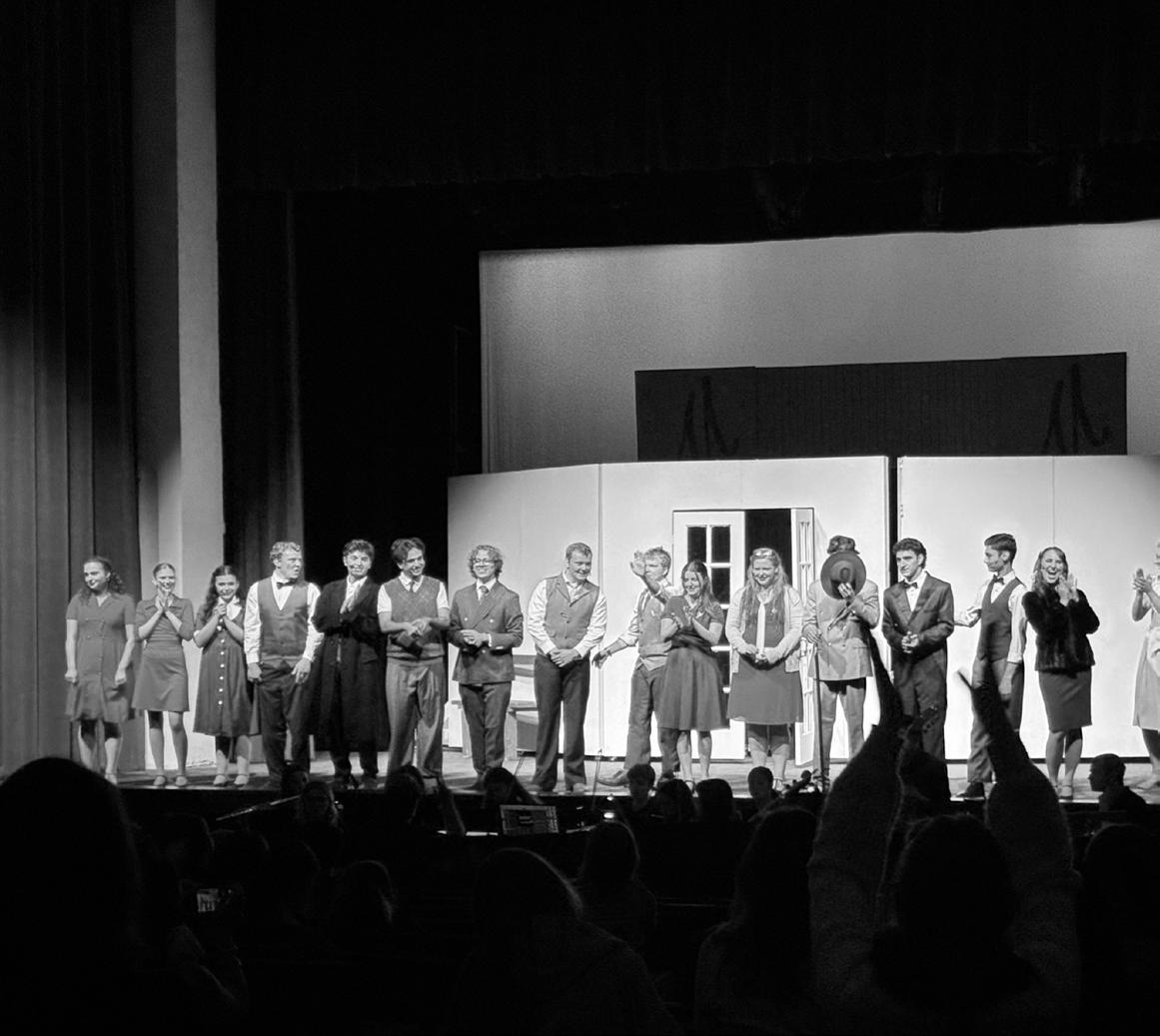
in dialogue. Amalia is often “Miss Balash,” Georg is “Mr. Nowack,” and that mismatch can leave newcomers, including me, left confused. For an audience that may include first-time visitors, a more detailed character list would be a low-effort, high-impact solution.
Taken as a whole, though, the show’s heart is intact. The leads warm each other slowly, as they should. “Vanilla Ice Cream” lands as a genuine turning point. The café sequence, its choreography, its comic restraint and its melancholy as the room cleared, was the evening’s best section. It is where performance, music and design met cleanly and where
the company’s discipline was most obviously shown.
So here is the honest balance sheet from a first-timer: The company delivers lively ensemble work, strong leads and an energetic café set piece, all on a one-month build. The production needs cleaner sound, steadier clarity in the program and more careful handling of one jarring plot moment. However, none of that cancels the achievement. It instead highlights how high the bar already is for a student troupe to produce four shows in only a year.
By curtain close, the show earns the same quiet payoff its lead pair finds: love, not in a rush, but through recognition.
By OWEN THEBERGE CONTRIBUTING WRITER
Only Doja Cat, the “Say So” rapstress, would reveal the album cover of her latest project “Vie” the Monday leading up to its release.
The cover features Doja Cat dangling from a parachute caught in a tree, which according to an Instagram caption written by Doja Cat herself, represents how “the pain from the fall teaches you that those scratches can be healed.” Does this explanation encapsulate the central themes of the album, or does it lead the listener astray?
“Vie,” an ’80s soundscape, opens with the groovy and snappy “Cards,” a memorable pop-hip hop blend that features Doja Cat urging an unnamed stranger to “take [her] wherever [they] want,” effectively introducing the character of the ‘stranger’ that is present throughout the project. It’s incredibly fun and an early highlight of the album, along with the next two tracks “Jealous Type” and “AAAHH MEN!” that are both some of the best tracks on the record with addictive hooks and punchy, nostalgic production. As fun as these tracks are, in some aspects, they are misleading, as they promise an album
full of Doja Cat-esque quirky tunes, which doesn’t hold up throughout the rest of the album.
Quirkiness has always been part of Doja Cat’s brand, but she takes multiple steps back from the silliness of “Vie,” with much more sensual, earnest themes, verses and production with the help of mega-producer Jack Antonoff and a string of other producers. The run from “Couples Therapy” to “All Mine” are all necessary additions to the story of the album, but all string together with similar downtempo production that gives off the feeling of sameness.
“Take Me Dancing” with long-time collaborator SZA brings back the funky and danceable feel of the first three songs in a much needed reprieve from the monotony of the previous tracks, with Doja urging the “stranger” to “take [her] dancing tonight” and that “it’s lonely out here / In this big old mansion.”
The chemistry between Doja and SZA is undeniable and flows well into “Lipstain,” a slower highlight of the record that preludes another stretch of flow-destroying monotony. The track “Silly! Fun!” is practically the opposite of its title in all regards, a
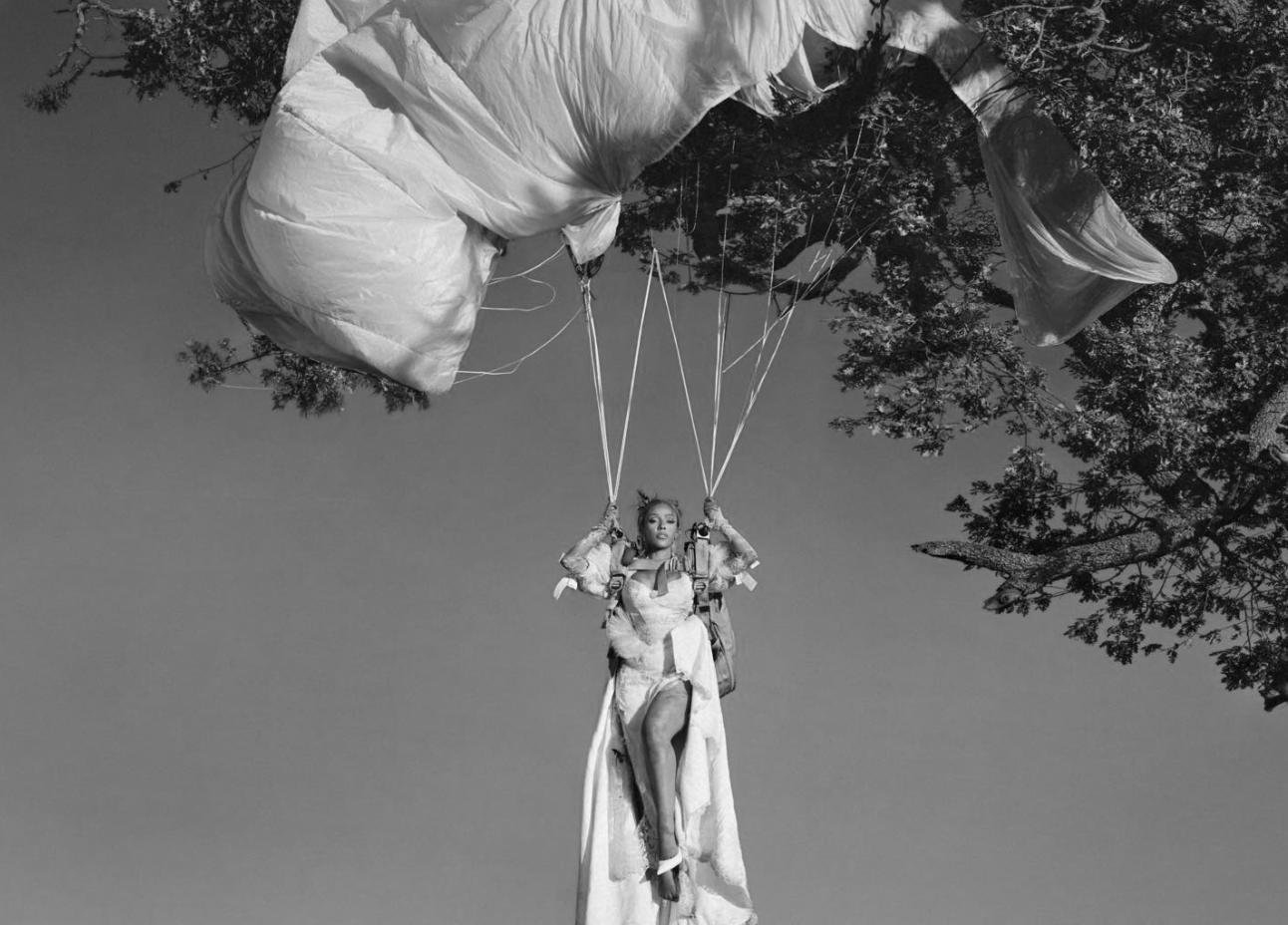
B-side track that feels more like a failed attempt to bring Doja Cat’s traditional flare into the more subdued, human world of “Vie.”
The following two tracks, “Acts of Service” and “Make it Up,” are slower, yes, but they provide more insight into Doja Cat’s insecurity with the aforementioned “stranger,” adding complexity to the “Vie” version of Doja Cat. These tracks, unlike “Couples
Therapy” and “All Mine,” key the listener into the importance of self-reflection through a mature lens that Doja Cat hints at throughout the album and prepare the very strong finish to the project.
The run from “One More Time” to “Come Back” is on par with the first three tracks, featuring some of Doja Cat’s most personal lyrics of her discography, mixed with fun
and groovy production that is sure to satisfy both new and old, fans and critics alike.
Overall, even if a little overstuffed, “Vie” feels like a crucial stamp on Doja Cat’s discography that highlights her emotional side in a complex and brand new light. So, to answer the question of whether or not Doja Cat’s caption sums up the album as a whole: oui.
By ERYNN SWEENEY ASST. CULTURE EDITOR
I’ve always loved listening to music, but making music has not always been my strong suit. When I was little, my parents put me in piano class with a teacher named Mrs. Mary, and it quickly became my least favorite time of the week. I would leave most lessons crying and needing candy to make me feel better. What I remember most is Mrs. Mary’s look of disapproval, being scolded for not hitting the right notes and feeling generally ashamed and frustrated (needless to say, not the point of music!).
Piano never quite stuck with me, but recently I’ve picked up the ukulele, and I think I’ve got a better shot at sticking with it.
I love to play the ukulele. I love its sound, its natural charm and its upbeat rhythm. I love learning new chords and trying to play new songs. I love the feeling of doing something with my hands, especially given how much of our work as students happens in our minds. I love the act of creating something that is fleeting — I can’t go back to playing the chorus of a song the same way I can go back to an essay on a Google Doc and continue to make changes. When I make music with the ukulele, the sound just is what it is, and I can’t evaluate
or fix it. It exists at a certain moment in time, and then it goes away. So I need to appreciate it while it is there.
Even though I love to play the ukulele, I would not say I am necessarily good at it.
Just ask my roommates. They can hear through the thin walls of our apartment as I struggle to change chord positions in time with the melody and to remember the difference between an E minor and a D minor chord and which one comes before the other in the song I am trying to play. They can hear me playing the same songs over and over to no avail.
As I write this, I wonder why I understand those two things — my love of playing the ukulele and also considering myself not quite skilled at it — to exist in tension. Can I love something and be bad at it? I think that the answer is yes.
I think it is important to engage in activities that are not about improvement, becoming “the best you can be”or focused on evaluation. So many other parts of life have become this way (school, for example, has in many ways become more focused on grades — an evaluative metric — than the process of learning: the experiential component) that it is easy to feel that this is just the way life is. But it doesn’t have to be this way.
I enjoy the unstructured
manner in which I am able to learn to play the ukulele. I can pick it up when it feels right and I can put it down when I’m finished. The goals and metrics I have in my learning process are ones that I create for myself, not ones that someone is creating and imposing onto me. Unlike the way that I learned piano, I can do it on my own terms without anybody scolding me for messing up. And this frees me to appreciate the actual experience of making music, not because it is something I am good at but because it is something that I love to do.
So yes, my ukulele is out of tune. I don’t quite play the right notes. I don’t practice enough, and that is okay. Because for me, sitting down and playing is a reminder that not everything has to be about working towards a goal. It reminds me of the importance of doing something just for the sake of doing it — not to become the best at it, not to achieve something, not to work up to an external standard, but just to do it.
I am not saying that there is no space in our lives for evaluation. Striving to improve at something (it doesn’t really matter what it is) is, in my opinion, very important and honorable. When you love something, you want to do it well. You want to be excellent. This is an essential part
of being human.
I am just saying that evaluation cannot be the only mode in which we live our lives. It can quickly go too far. There needs to be space for both evaluation and enjoyment, for improvement and experience. Or else, we come to see ourselves as machines — centered around generating output and crossing things off our to-dolists — and life becomes tragically transactional. Our mental narratives become about doing something in order to achieve something else in order to move onto the next thing and do it all over again.
Engaging in creative outlets such as music reminds me that there is more to life than this. The other side of the story, to me, sounds a little something like, “A minor, G, C. Down two times, up two times, down and up again.”
Maybe one day I will try to get better at playing my ukulele. But right now, I don’t really want to. I am content with playing The Beatles’s “Let it Be” and Vance Joy’s “Riptide” over and over again (sorry, roommates). I just want to make some music every now and then in my dorm room. When will that be enough?

3. ACTIVIST WHO WON FOR HIS OPPOSITION TO SOUTH AFRICAN APARTHEID
6. FORMER VICE PRESIDENT WHO WON FOR HIS WORK RAISING AWARENESS FOR CLIMATE CHANGE
7. FORMER US PRESIDENT WHO WON THE PRIZE FOR HIS WORK PROMOTING PEACE
1. CATHOLIC NUN WHO FOUNDED THE MISSIONARIES OF CHARITY
2. A PAKISTANI ACTIVIST WHO WAS THE YOUNGEST NOBEL PRIZE LAUREATE IN HISTORY
4. MAN WHO WON IN 1964 FOR HIS LEADERSHIP IN THE CIVIL RIGHTS MOVEMENT
5. THE 44TH PRESIDENT OF THE U.S. WHO WON FOR HIS DIPLOMACY



By JOE HENRY ASST. SPORTS EDITOR EMERITUS
We are now two weeks into the 2025 Atlantic 10 (A-10) volleyball season. Fordham University Volleyball, the last-place selection in the A-10’s preseason poll, is off to a winless start.
The good news? Fordham won’t have to see the A-10’s two active powerhouse schools again all regular season.
While most A-10 teams faced two solid opponents, one great and one less-than-great opponent, or some other balanced combination of early-season foes, the Rams faced the conference’s reigning champions and runnersup in consecutive weeks to start the season.
In its season-opener against 2024 A-10 champion Loyola University Chicago, Fordham took a set and stayed close in their two defeats.
Facing the Dayton University Flyers last weekend in Ohio, Fordham lost 3-1 on Friday, 1325, 23-25, 29-27, 14-25 and 0-3 on Saturday, 17-25, 12-25, 14-25. Dayton advanced to the Sweet 16 last year, and were ranked #12 nationally. In the preseason poll, the Flyers were unanimous favorites to win the A-10. For years, they’ve far outmatched their A-10 competition. Last season, I likened them to volleyball robots.
While Dayton demonstrated dominance in its day two sweep, the Flyers appeared like something they hadn’t all of last year for most of Friday: human. Fordham had the Flyers on the
ropes in set two before a late-set collapse. In set three, Fordham burst out to a 16-7 lead. While a late Dayton run closed the gap, the Rams closed out a nail-biting 2927 win.
They did so in the oddest of ways.
Sometimes, some teams just match up better than others. Fordham’s super block found its kryptonite in Dayton. Dayton’s frequently reliable serve-receive met its match against Fordham’s notably conservative service.
Over the weekend, Fordham posted 13 blocks — its lowest output in a two-match stretch since their opening weekend in August. Junior Tatum Holderied had just four combined rejections, a season low.
In exchange, the Rams executed a season-best eight aces in their set three win. Five came from Holderied in one improbable 9-0 run, during which Fordham flipped a 3-1 deficit to a 10-3 lead.
Knuckleballing float serves into the gray area between Dayton’s front and back rows, Holderied, a 6’4” middle blocker better known for her touch at the net than at the baseline, served as many as three consecutive aces, to the bewilderment of just about everybody in the building.
Entering the season, Holderied had zero career aces. She now leads the team with an astonishing 16.
To underscore the historic nature of her season-to-date, it should be noted that Holderied’s low blocking outputs have lowered

In Fordham’s meet vs. Towson University on Oct. 3, graduate student diver David Vargas made an impressive Ram debut. He set school records in both diving events of the day, scoring 382.43 points in the one-meter board event and 412.58 in the three-meter board event. Vargas had two of Fordham’s seven event wins in the men’s team’s 185-115 loss to Towson.
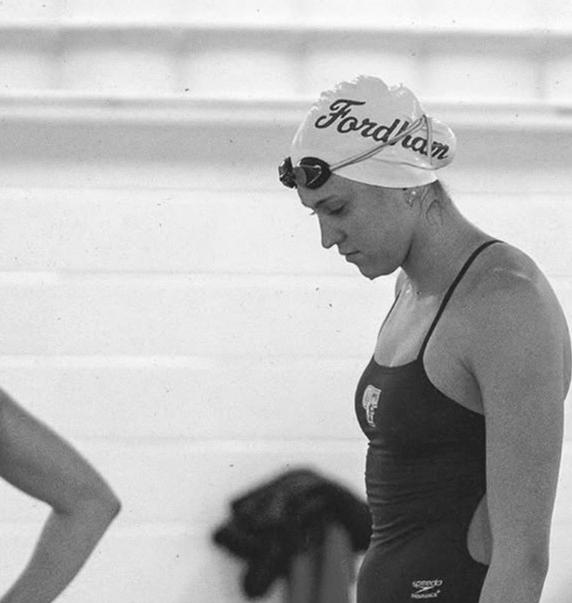
In her Fordham Swimming debut Friday, sophomore Karina Kanary was part of four of Fordham Women’s Swimming and Diving’s 12 total event wins against Towson University, including three individual wins. She took first place in the 100 breaststroke, 200 breaststroke and 200 individual medley. She was also one of the legs in the first-place 200 medley relay team. Kanary helped lead the Fordham Rams to their 159-141 win over Towson at their opening meet of the season.
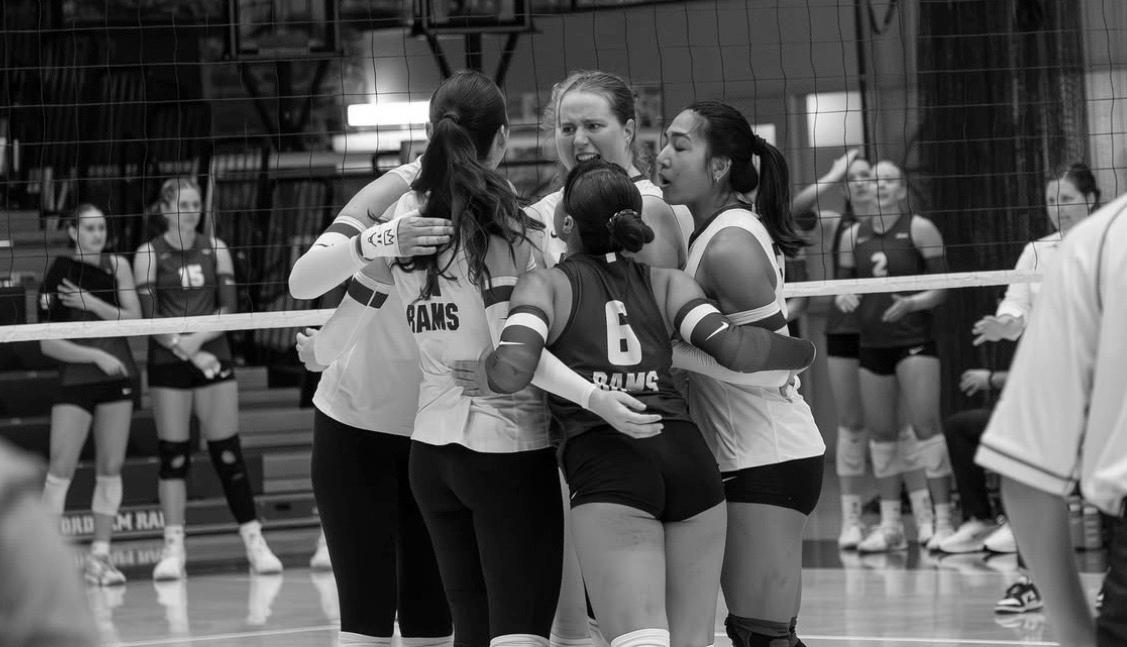

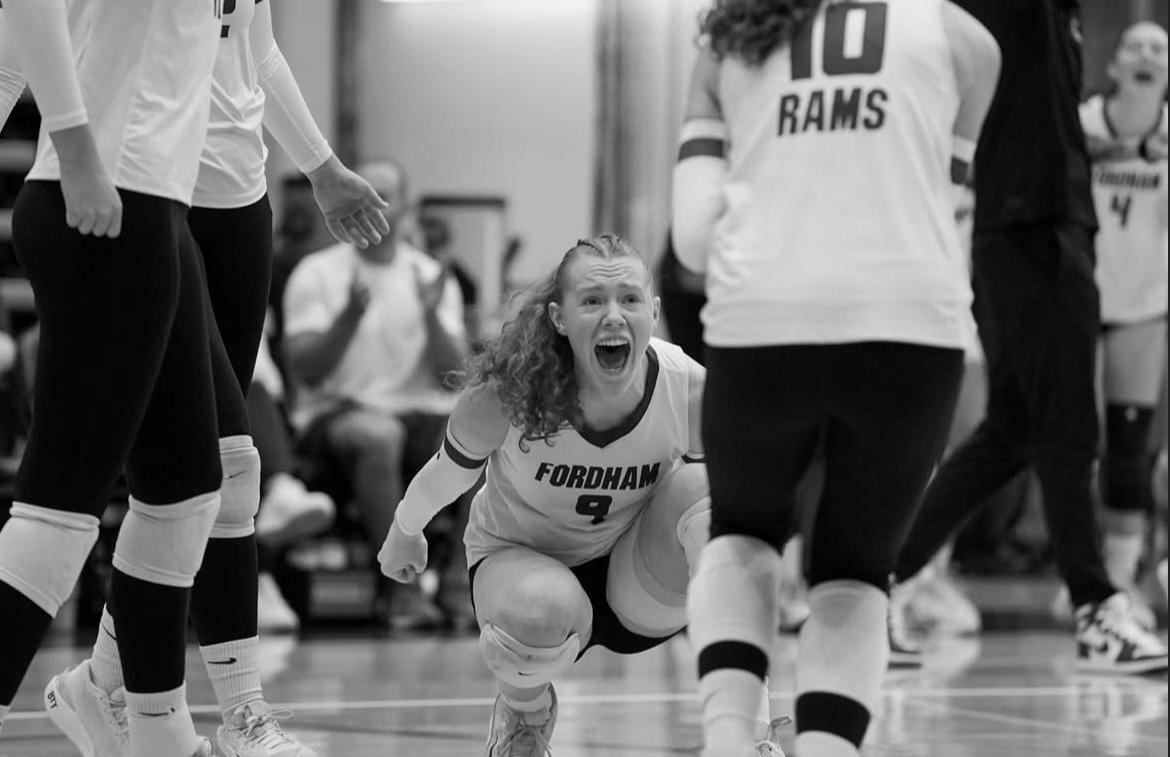
her national ranking in blocks per set from #1 to… #1. The Rams, as a team, are still ranked #3.
Last year, when Dayton swept Fordham in consecutive days, it felt like the series that officially exhausted whatever air remained in Fordham’s already-deflated playoff chances.
This year, it feels like another reminder that the Rams can compete with anyone.
Indeed, for a second straight week, Fordham managed to win a set against a historically hard-tobeat program — a feat they hadn’t accomplished against either team since at least 2022.
Again, a set win isn’t a match win, but it is indicative of something this team didn’t have much of a season ago: hope.
Fordham just competed well against, subjectively, the two best teams in the conference. The worst of the team’s schedule is already behind them. No other team can say that.
What’s more? If all goes to coach Ian Choi’s plan, the Rams just
played their worst four matches of the conference campaign.
Entering A-10 play, Choi expressed concern about the plight of teams “peaking too early” in the season. “We have a balance and a team identity in addition to making sure we peak at the right time,” said Choi. “We’re seeing a lot of good things.”
The Rams will look to turn spurts of positive results against the A-10’s best into a win against a fellow 0-4 team: the University of Rhode Island (URI).
This time last year, Fordham played its annual intra-week match with URI in Kingston, Rhode Island and suffered a shocking sweep against the bottom-dwellers of the conference. This season, it feels imperative that they take care of business.
It’s especially important to build momentum with a scary George Washington University team traveling to the Bronx, New York, this weekend. The Revolutionaries were picked to finish fifth in the
A-10, but have leaned on a stellar recruiting class en route to a 3-1 start — they even earned a win over Loyola Chicago last weekend.
Another question looms: How can the team fare in its first week of conference play with three matches? Choi spoke extensively during the non-conference season about giving his student-athletes holistic rest: “It’s not just the physical and athletic fatigue. It’s the mental fatigue too....rest is absolutely critical.”
The Rams will need to avoid the same fatigue that led to their blowout loss to Dayton last Saturday, while maintaining the spark that has willed them to unprecedented set wins in consecutive weeks.
A critical juncture of the team’s 2025 season begins Wednesday, Oct. 8, at home in the Rose Hill Gym, with first serve between URI and Fordham at 5 p.m. The Rams will then welcome the George Washington Revolutionaries to the Rose Hill Gym for two matches this weekend.
KURT SIPPEL STAFF WRITER
Basketball in New York is a sacred institution. Everyone in New York is a basketball fan, but it hasn’t been easy over the last few years. This year, fans are praying for change.
The New York Knicks and the Brooklyn Nets are in different stages going into the 2025 season. The Knicks are beginning to retool and run it back by improving their bench and bringing in a new head coach. The team hopes to make a deeper push with its core players, Jalen Brunson and Karl-Anthony Towns and resigned Mikal Bridges.
Meanwhile, the Nets are in a full-on rebuild, after using all five of their first-round picks in the 2025 NBA draft to develop talent and build for the future.
The Knicks have a lot to prove after firing former Head Coach Tom Thibodeau, who had a record of 226-174 in five seasons. In his last season at the helm, the Knicks lost to the Indiana Pacers in the Eastern Conference Finals (ECF). It was the first time the Knicks reached the ECF in 25 years.
After a long search for their next leader, the Knicks landed on Mike Brown, former head coach of the Sacramento Kings. When Brown was the Kings’ head coach, he worked to turn the Kings around. He put up a 107-88 record in his two full seasons with Sacramento. Brown was the second head coach to have a winning season with the Kings since they moved to Sacramento.
His philosophy differs from how the Knicks playbook has looked recently. Brown favors a very high pace of play utilizing organized chaos, a style he picked up when he was an assistant coach with the Golden State Warriors.
Brown wants every player constantly moving on the court to attempt to create the best possible shot on offense. This is different from how the Knicks
have operated previously — Brunson usually takes his time with the ball and brings it up the court before making any decisions.
After the Knicks preseason game in Abu Dhabi, Brown spoke to the media after the Knicks took down the Philadelphia 76ers 99-84 in a lopsided win. Knicks fans got to see almost their entire team play with their brand new offense.
“Our guys did a pretty good job with their pace, but we have to play faster and we can play faster,” Brown said in a press conference. “It was great because our guys got a taste of how fast we need to play, and they know we still have to take it three or four more notches.”
Knicks stars Towns and Brunson have a lot of skills but aren’t known to be very fast paced players. This past offseason, the Knicks brought on Jordan Clarkson from the Utah Jazz, a guard who plays fast-paced.
Clarkson will fit right into Brown’s offense as one of the fastest players on the New York roster. Clarkson will be able to speed things up and spread the ball out to the other players on the floor.
The Knicks also attempted to shore up their very short bench that caused them issues last season by signing Malcolm Brogdon, one of the most veteran guards in free agency. During his stint off the bench with the Boston Celtics in 2022, he averaged 14.9 points per game and 3.7 assists per game, hitting 44% from the 3-point line.
Brogdon floated around the league with the Washington Wizards and the Portland Trail Blazers for the last few years.
This will be the first time since 2022 that he will be on a contending team.
This is a “prove it” season for the Knicks, who have been inching towards the right direction, but haven’t been able to make it to the big dance just yet.
The Knicks have the skills of
a championship team, but it remains to be seen whether their stars will be able to take another step in Brown’s new system.
In Brooklyn, the Nets are now in full rebuild mode under Coach Jordi Fernández. The Nets took five players in the first round of the 2025 draft, picking up Egor Dëmin, Nolan Traoré, Ben Saraf, Danny Wolf and Drake Powell.
This is a complete youth movement combined with returning players like Nic Claxton and Cam Thomas. The offseason chaos finally came to an end when Thomas signed a one-year deal to stay with Brooklyn.
Some of the Nets pickups in the offseason came from a trade that sent Cam Johnson to the Denver Nuggets, and the Nets received Michael Porter Jr. will play an increased offensive role with the Nets after playing behind Nikola Jokić and Jamal Murray.
Along with Porter, the Nets signed veteran Terance Mann from the Atlanta Hawks. Mann, along with Porter and the other returning Nets veterans, will take up a leadership role to support the rookies.
While the Nets might not be very competitive this season, if you are a fan, there is a lot to look forward to, with continued progression of young players like Noah Clowney and Day’Ron Sharpe.
Last season, Fernández showed poise as the Nets’ leader, even though he was not dealt the best hand with his roster. Even though the team might not have showed up for him, his team stayed competitive in most of their games.
It is going to take a few years for general manager Sean Marks and Fernández’s plan to start coming together.
Finally, it feels that the Nets are starting to build towards something that fans can get behind and root for a fun young team that might surprise some viewers.
Football Fordham 26 Lafayette 21
Men’s Soccer Fordham 5 Loyola Chicago 1
Men’s Tennis Atlantic 10 Masters (No Individual Scoring)
Women’s Tennis Fordham Invitational Atlantic 10 Masters (No Individual Scoring)
Men’s Swimming & Diving Fordham 115 Towson 185

LEAH RENSHAW CONTRIBUTING WRITER
On Saturday in Pennsylvania, Fordham’s Football team couldn’t get anything going for three quarters, and by the time their offense woke up, the game was out of reach. The Lafayette College Leopards’ defense set the tone early and handed the Rams a 24-10 loss at Fisher Stadium.
The Leopards held the Rams scoreless until the fourth quarter, despite another strong outing from junior quarterback Gunnar Smith, who threw for 354 yards and a touchdown.
Sophomore receiver Jack Freeburg is making a name for himself this season.
Freeburg had a career-best 113 receiving yards against Lafayette, while freshman Troy Worrell added 91 yards and a touchdown.
Graduate student linebacker James Conway led the Rams’ defense once again with 11 tackles, adding to his Patriot League record of 522. Defensive back Boogie Owens added nine tackles and an interception, as Fordham’s defense held Lafayette to just 83 rushing yards, which was well below its season average of over 200.
Lafayette was led by quarterback Dean DeNobile. DeNobile passed for 314 yards and two touchdowns on 25 completions, helping the Leopards to stay in
control. He also played a key role in keeping Lafayette’s offense efficient during their early scoring drives. With the loss, Fordham falls to 1-5 overall and 1-2 in the Patriot League. Lafayette moves to a record of 4-2 and remains undefeated in Patriot League play at 2-0.
In the end, Fordham’s attempt at a late rally was not enough to overcome a slow start and Lafayette’s strong defense. With the season entering its second half, the Rams will need to build on the positives and regroup quickly to turn things around. They have a bye week next week, and then will return home to face Dartmouth College for homecoming Oct. 18.
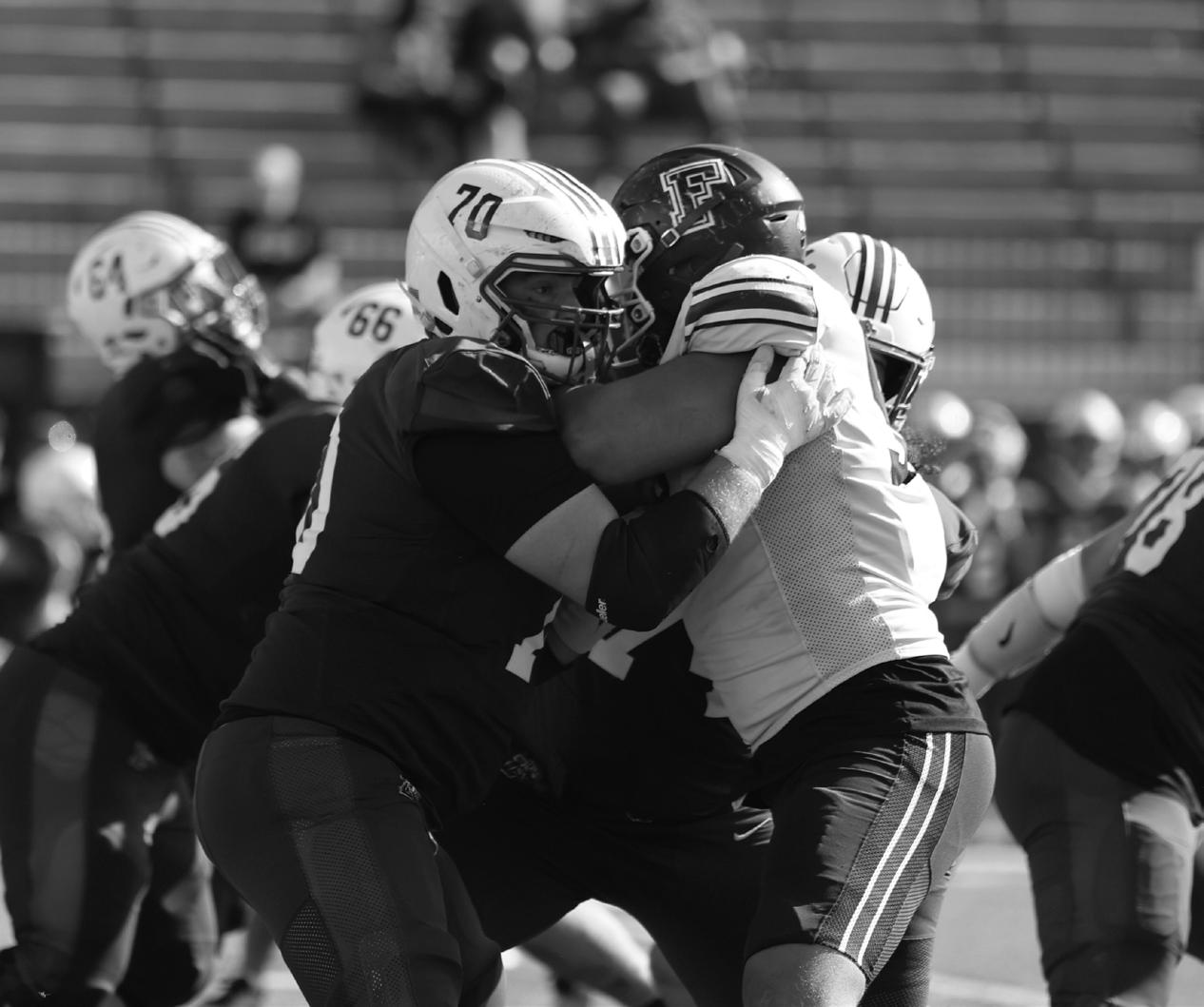
By IAN NELSON ASST. SPORTS EDITOR
Win or lose, the Ryder Cup is a tradition and highlights the best golfers from both the United States and Europe. This year, at Bethpage Black Golf Course in Farmingdale, New York, Team Europe secured a dramatic 1513 victory, holding off a fierce U.S. comeback on Sunday. Team Europe’s Shane Lowry’s crucial half-point secured the overall win for Europe, who had dominated the earlier sessions to build a commanding lead. The win marked Europe’s first Ryder Cup victory on U.S. soil since 2012 and their ninth in the last 12 competitions.
We lost, but what happened to losing gracefully? Golf fan etiquette emphasizes respect for the players, the game and other spectators by remaining quiet and still during shots, turning off cellphones and other electronic devices and staying in designated areas. A good fan cheers for good shots and offers encouragement after mistakes, but never ridicules or mock a player’s misfortunes. Using these unwritten rules as a baseline for good behavior, Team U.S. fans did nothing short of bringing shame to our country on a national level,

with the taunting of players from Team Europe at every opportunity and failing to show an ounce of decorum. If you want to be raucous and rowdy, go to a football game, because golf isn’t the sport for you. From Sept. 26-28, no one had to deal with more abuse from the spectators than Rory McIlroy. McIlroy, one of only seven grand slam winners in golf history, faced profane chants and abusive behavior from U.S. fans at the Ryder Cup. The ridicule didn’t stop at verbal abuse toward him either.
At one point on Saturday, a cup of beer sailed out of the crowd and hit the brim of McIlroy’s wife’s hat, as she
was walking alongside her husband.
Don Rea, president of the PGA of America, initially compared the behavior of Ryder Cup fans at Bethpage Black to parents at a youth soccer game, saying, “Well, you have 50,000 people there that are really excited, and heck, you can go to a youth soccer game and get some people who say the wrong things.” Rea seemed to make light of the situation before switching his tune later on in the week. According to a report by the Associated Press’ Doug Ferguson, Rea sent a letter to PGA of America members acknowledging the inappropriate behavior and
expressing regret. “Let me begin with what we must own. While the competition was spirited — especially with the U.S. team’s rally on Sunday afternoon — some fan behavior clearly crossed the line,” Rea wrote. “It was disrespectful, inappropriate, and not representative of who we are as the PGA of America or as PGA of America golf professionals. We condemn that behavior unequivocally.” Big words for someone who said nothing while it was going on. The verbal abuse wasn’t restricted to just the fans. The event’s master of ceremonies, Heather McMahan, even stepped down and apologized after leading the fans in a chant of
“f**k you, Rory” with a live microphone. She has since apologized in a statement made on her “Absolutely Not” podcast, saying she did not start the chant and only participated in it once. Seems too little too late. If you’re going to apologize and make every excuse you can, don’t join the chant in the first place. It’s disrespectful to the game.
When asked about the language used by American fans towards European players, Team Europe’s Tyrrell Hatton said, “I would much prefer it to be a respectful atmosphere. You let the guys play and the best team wins, rather than trying to affect the outcome by trying to put off players or things like that. But I don’t think it will be as hostile as maybe it was last week. I’d like to think that it will be very respectful.”
If you need to tamper with the playing conditions to get the win, you don’t deserve it. That doesn’t mean that I didn’t want Team U.S. to come out on top, of course I was rooting for them, but watching how we represented ourselves in front of the world made me sick. All that the taunting and yelling only made us look unpleasant, uncivilized, reproachable and, frankly, second-class.
By JACOB WOLFER MANAGING EDITOR
With the 2025 Major League Baseball’s (MLB) regular season over and the playoffs in full swing, the Baseball Writers’ Association of America (BBWAA) will soon have a difficult decision to make when it comes to who should be named American League (AL) Most Valuable Player (MVP).
Aaron Judge of the New York Yankees and Cal Raleigh of the Seattle Mariners are the clear front-runners in the race.
From an offensive standpoint, Judge clears Raleigh in nearly every statistical category. In the 2025 regular season, Judge put up a batting average (BA) of .331 with a .457 onbase percentage (OBP) and an on-base and slugging percentage (OPS) of 1.145 compared to Raleigh’s BA of .245, OBP of .359 and OPS of .948. Should the AL MVP be decided by offensive stats, Judge wins, despite Raleigh’s impressive 60 home run (HR) season. Although Raleigh’s 60 HRs made him the first catcher in MLB history to accomplish the feat, Judge’s impressive BA and consistency at the plate make for a much better season offensively. However, when considering that baseball has

always prioritized catching as a “defense first” position, Raleigh’s bid for the AL MVP becomes much more enticing.
The last catcher to win MVP was San Francisco Giants legend, Buster Posey, in 2012. Posey arguably put up the best single-season performance ever by a catcher. Posey finished the season with a BA of .336, an OBP of .408 and an OPS of .957. However, what was perhaps more impressive about Posey’s 2012 season was his defensive performance. The backstop hosed down 38 runners on 125 attempts, giving him a caught stealing percentage of roughly 30%.
In addition, Posey only allowed two passed balls on the year in 138 games played behind the dish. The precedent set by the BBWAA in electing Posey as the MVP sets the path for Raleigh to be named AL MVP despite Judge’s ridiculous offensive numbers.
Raleigh’s defensive performance this year has arguably been the best in baseball. Raleigh has caught in 125 games, committing only four errors and boasting a .996 fielding percentage. He has thrown out 21 baserunners, putting him well within the top half of catchers who have thrown
out the most baserunners this season. In addition to this, he is one of only two catchers in the MLB this year to not allow a single passed ball. Raleigh is also regarded by several MLB analysts as one of the best framers and blockers in baseball, consistently stealing strikes for his pitchers and giving them confidence to bury a breaking ball with runners on. Good catchers are paramount to playoff runs. Although the Mariners have a loaded pitching staff with players like Logan Gilbert and Luis Castillo, Raleigh has been the glue that has held the Mariners together, which is not something that can be shown
through stats alone. When one pairs Raleigh’s impressive defensive performance this year with his league-leading 60 HR season, the argument for who should be the AL MVP becomes significantly closer.
It is my belief that any time a catcher performs well defensively and accomplishes a milestone never before done by someone in that position, that alone is worthy of an MVP award. Catching is widely regarded as the hardest position in baseball and is extremely unforgiving physically. Should the BBWAA decide not to elect Raleigh as the AL MVP, they would be breaking an unwritten rule in baseball by not awarding a player who is expected to perform well in every aspect of the game over another player who is simply paid to hit home runs. Although Judge is a reliable outfielder, no one will remember his 2025 performance for his defensive accomplishments, but Raleigh will be remembered not just for how he performed behind home plate but also for setting a new record and standard for catchers as hitters. Because of Raleigh’s accomplishments both defensively and offensively this season, he should be this year’s AL MVP.
By EMMA LEONARDI ASST. NEWS EDITOR
Imagine almost making the World Series and starting off a new season as one of the best teams in baseball, just to fall an inch short of the playoffs. This was the reality for the New York Mets during the 2025 baseball season.
They began the season in the spotlight: This would be their first season with Juan Soto following his recordbreaking contract signing with the Mets in December of 2024. Following a promising spring training, the Mets started the regular season strong, quickly rising to the top of playoff contention in early April, but it would slowly slip from their grasp over the course of the summer, until they finally lost it on Sept. 21.
They would go on to lose the final National League (NL) Wild Card spot, forgoing any chance at a playoff appearance as the Cincinnati Reds usurped them. But where did they go wrong?
First off, there was a consistent dependency on the big four of the team: Francisco Lindor, Juan Soto, Pete Alonso and Brandon Nimmo. In fact, as statistics would show at the
By

end of the season, these four hitters had a batting average of .266, while the rest of the usual lineup had an average of .218. They would also lead the team in home runs and runs batted in (RBIs), as their average was 34.25 home runs and 102.25 RBIs, compared to the rest of the team’s average of 5.44 home runs and 21.06 RBIs. If you’re looking for a playoff spot, you need to be able to rely consistently on more than four players in your lineup.
The Mets also showed fault in the amount of times runners were left in scoring position. This began to be a major problem in June, with the Mets
ranked as the fourth worst batting average with runners in scoring position at that time. Despite this issue presenting itself in the first half of the regular season, they continued to struggle with it throughout the second half, which concerned fans about the perceived lack of effort in fixing this problem.
There was also a major issue of pitching. The bullpen was severely lacking, with only a few solid pitchers on the whole roster. The supposed pitching stars Sean Manaea and Kodai Senga significantly underperformed when compared to beginning of the season expectations,
and David Peterson fell off following the All-Star break in July. Without a consistently reliable bullpen, there is no hope to advance to the playoffs.
Finally, leaving fans infuriated: The Mets went 0-70 in games where they were losing by the eighth inning. This means that there were no ninth-inning comebacks in 2025, which is something that fans came to rely on following the 2024 season. When you give up trying to win games just because you’re losing in the last inning, it only makes sense that you give up your claim to a playoff spot as well.
Now that the Mets are decidedly not October ready, there is a new question in fans’ minds: Will they be ready for the 2026 season?
Alonso is now a free agent after opting out of the second year of his contract. As he leads the team in home runs and RBIs, the ability to retain him is going to be the biggest factor in how the Mets perform next year. His departure would not only leave a huge gap in the batting order, but it would also be a major stab in the heart for all Mets fans.
The Mets cannot rely on him remaining with the team, even if he elects to
stay. The bullpen has to get stronger across the board, and the bottom of the batting order needs to step up and stop relying on the top four.
Owner Steven Cohen posted an apology, telling fans he is already looking into how to do better next year.
“Mets fans everywhere. I owe you an apology. You did your part by showing up and supporting the team. We didn’t do our part. We will do a post-mortem and figure out the obvious and less obvious reasons why the team didn’t perform up to your and my expectations. We are all feeling raw emotions today. I know how much time and effort you have put into this team. The result was unacceptable. Your emotions tell me how much you care and continues to motivate the organization to do better,” Cohen shared on X. Cohen’s words are just words right now, but hopefully they will become reality. Part of being a Mets fan is constantly being let down and still remaining a dreamer. Maybe 2026 will finally be the year fans can meet the Mets at the World Series.
Loved by their fans and hated by nearly everyone else, the New York Yankees have a unique reputation in baseball as the most accomplished franchise in history. Past generations of fans have witnessed the Yankees win countless titles. However, the current generation of Yankees fans have endured a drastically different experience.
The Yankees have struggled, getting eliminated in the first round of the playoffs in 2015 and missing the playoffs again in 2016. 2017 marked the start of a new era in the Bronx. In his rookie season, Aaron Judge smashed 52 home runs and led the Yankees through a deep postseason run. New York notched a comeback win in the Wild Card to defeat the Minnesota Twins before upsetting the top seed Cleveland Indians in the American League Divisional Series (ALDS). In the best-of-seven American League Championship Series (ALCS), the Yankees took a three games to two lead over the Houston Astros before losing the last two games. While the 2017 season ended in heartbreaking fashion, it introduced young Yankees fans to the euphoric experience that was winning in the playoffs.
After 2017, Yankees fans endured a brutal stretch as they watched the team suffer playoff eliminations from the Boston Red Sox in 2018 and 2021, the Astros in 2019 and 2022, the Tampa Bay Rays in 2020 and missing the playoffs in 2023. Throughout this period, the Yankees never came closer to a World Series
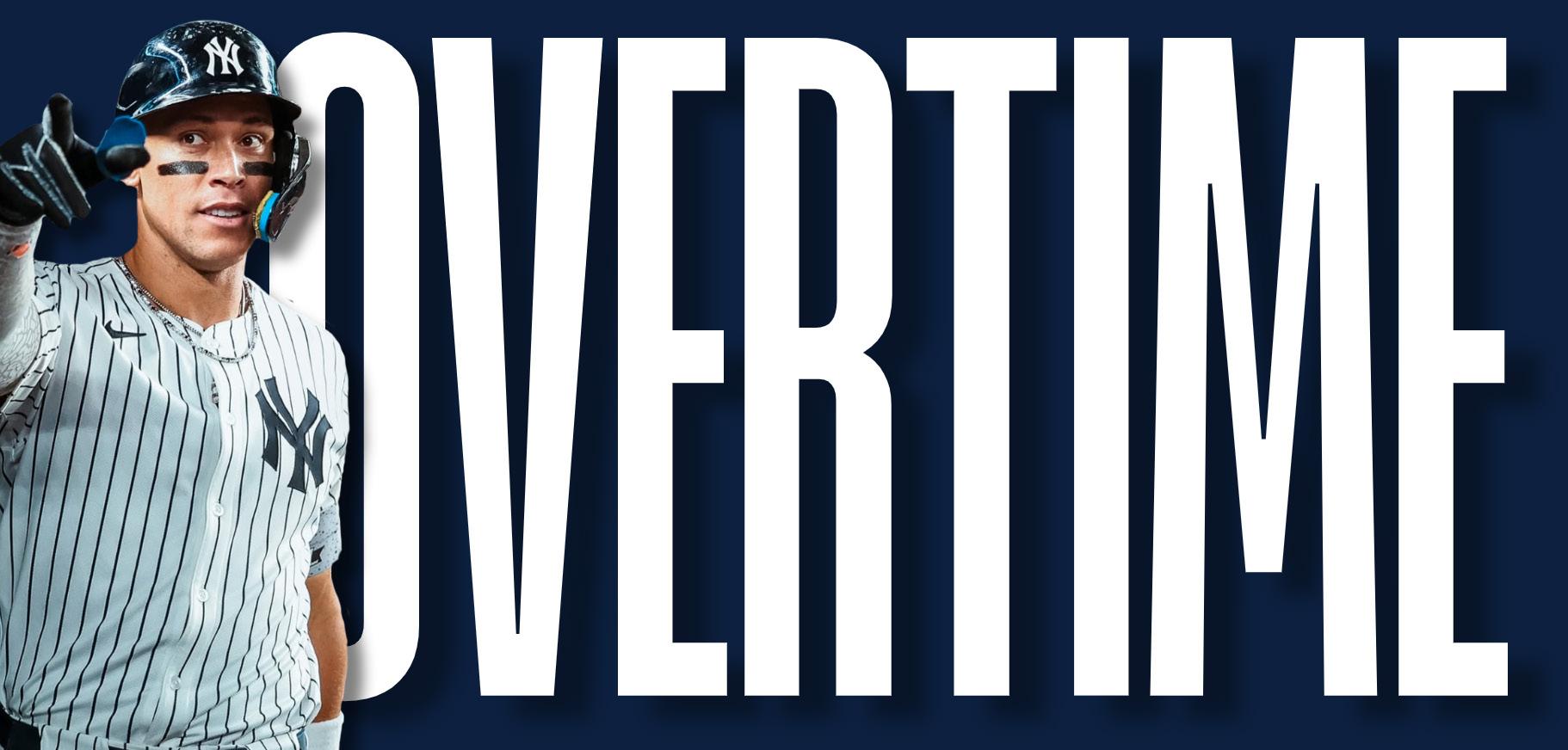
appearance than they did in 2017.
After missing the playoffs for the first time in the Aaron Judge era, the Yankees front office made a monumental move before the 2024 season.
The San Diego Padres traded Dominican superstar Juan Soto to New York, adding serious firepower to their offense. The trade paid off as Soto clubbed a go-ahead home run in the deciding game of the ALCS to send the Yankees back to the World Series after 15 years. Oftentimes when younger Yankees fans tout the teams league leading 27 championships, they are reminded that they were either not alive or merely toddlers the last time New York won it all. This was the Yankees’ best chance yet to provide the new generation with a championship memory of their own, and they failed.
The Los Angeles Dodgers defeated the Yankees in five largely uncompetitive games. With each year’s painful closure, fans have come to expect traumatic experiences come October.
So where have the Yankees gone wrong? How has the organization only managed one championship in the last 24 years? Run by the Steinbrenner family, the Yankees consistently have one of the biggest budgets in the league, spending well over $200 million on player contracts. Each offseason, the front office signs talented free agents and makes blockbuster trades that lead fans to expect championship-level baseball. Despite the high spending, the Yankees front office has failed to construct strong overall rosters.
Take the 2020 season for example, while the Yankees acquired elite pitcher Gerrit Cole on a nine year contract, they made no notable additions to the offense. Aside from outfielders Aaron Hicks and Brett Gardner, no other Yankees starters were lefthanded hitters. This proved to be a massive weakness in the playoffs when the Rays pitching staff dominated New York’s poorly structured lineup.
Another instance of an incomplete roster compromising the Yankees occurred over the last two seasons. This was when the Yankees acquired utility player Jazz Chisholm Jr. from the Miami Marlins and stationed him at third base. Chisholm had no experience playing third and struggled throughout the 2024 season. With no other choice but to move Chisholm away from third, New York needed a new third baseman. Rather than exploring free agency or the trade market, the Yankees reassigned utility player Oswaldo Cabrera to third. This move limited Cabrera’s contributions to the team, as his greatest strength was his ability to play numerous positions.
A topic of debate amongst fans is whether manager Aaron Boone is merely a puppet of the front office. Fans speculate that the Yankees analytics department and front office have Boone manage based on their predetermined strategy rather than managing with his intuition. However, fans
constantly demand Boone be fired, contradicting their theories about the Yankees’ management.
Compared to most sports fanbases, Yankees fans are spoiled. It has been over 30 years since New York last had a losing record. The team rarely misses the playoffs. The fans’ high standards don’t only stem from New York’s winning history, Yankees ownership are vocal about their championship aspirations. Owner Hal Steinbrenner has said on numerous occasions that a season that doesn’t end with a World Series title is a failure. Through Aaron Judge’s first eight years with the team, he has played out a career that some already consider to be Hall of Fame worthy. With six years left on Judge’s contract, the Yankees have a window of opportunity to build a championship caliber team around their star. If they don’t succeed, the Aaron Judge era will be looked back on by fans as the single worst wasted opportunity in Yankee history.